 |
SALLY GATES recommends |
|
| JOHN ZORN’S TABOO AND EXILE |
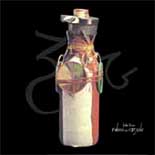 |
I came across this album shortly after I moved to NYC in 2018, and it brings me back to that time of impressionable discovery. The title alone intrigued me; it conjures this world of mystery and secret knowledge, with the opening piece setting a dreamlike space through hypnotic percussion. The plethora of musicians on it is staggering - to name a few: Fred Frith, Marc Ribot, Cyro Baptista, Joey Baron, Dave Lombardo, and Mike Patton.
The record takes you on a journey through many textures and styles, such as tribal drumming, surf guitar, dissonant arco movements, and the contrasting vocals of Patton and Miho Hatori. It moves through multiple ensembles, rather than having one core band, allowing you to encounter many distinctive musical personalities. This builds to a climax on 'The Possessed' where Zorn enters on saxophone for the first time.
One of my biggest takeaways from listening to Zorn's music is that with a solid vision you can truly do anything, and make the most unlikely and idiosyncratic ideas work. When I first started to explore his music and heard this album, I was in the middle of writing the first Titan to Tachyons album, and this realisation was huge in giving me the encouragement to see through my own ideas, no matter how abstract. |
 |
DAN WEISS recommends |
|
| TREVOR DUNN’S NOCTURNES |
 |
| I consider myself lucky to have worked with such a great musician over the years. This recording spotlights Dunn's compositional abilities. I remember when he was in the composing process for this record. The string quartet, nocturnes, trio for piano, violin, bass, and the melody for bass and string quartet are all beautifully rendered and performed on this lushly recorded cd mastered by the brilliant Scott Hull. The cd also has an amazing photo of Trevor. Sums him up! |
 |
ANNA WEBBER recommends |
|
| MORTON FELDMAN’S PATTERNS IN A CHROMATIC FIELD |
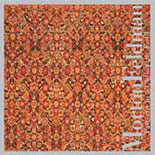 |
I’m definitely not alone in this, but Feldman was very important to me as I started figuring out who I was musically. When I was living in Berlin in my late twenties, I went to a lecture by Bunita Marcus at the Universität der Künste entitled “Feldman’s Notation of the Sound-Mass and its Acoustical Reality”. The lecture was fascinating; an inside look into the process and philosophy of one of my favorite composers from someone who had been extremely close to the source. I took copious notes. Something I wrote down from that lecture that is still a guiding light for me as a composer is “what we hear in our heads isn’t necessarily translated to the audience… it’s our job to figure out how to translate that to their imagination. We tend to be too idealistic”.
Patterns in a Chromatic Field is an incredible recording. The way it’s recorded is super intimate - you can hear hammer noise, pedal noise, string noise, breath noise. It’s like you’re at a house concert and are sitting on the floor three feet away from the performers. The piece itself is a balance of contradictions - highly timbral despite being entirely pitch-based, repetitive yet somehow never settling into one structure, anxious rapid shifts yet still meditative and melancholic. It is a study in aperiodicity, extreme register, a blocky form that still achieves a steady coherence. This piece has been and continues to be an inspiration to me for all of these reasons, but above all for the skillful translation of ideas from the composer’s head to the visceral experience one has while listening. |
 |
DAN KAUFMAN recommends |
|
| PAMELIA KURSTIN’S THINKING OUT LOUD |
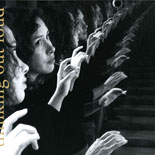 |
On this magisterial record, Pamelia not only proved that another world was possible — she created one. The seven pieces here, all of them improvised in venues, homes, and studios in Europe and New York, have their own personalities yet unfurl like a single, seamless dream. Layered theremin lines slowly and patiently create beautiful, complex structures that shift, collapse, and then take on new forms all within a single piece. Dense thickets of celestial harmonies are interrupted by bass lines that appear out of nowhere, like raindrops on a rooftop. The brief forays into guitar and piano evoke early 20th century Paris, but the origins of this music remain enigmatic.
Music made by friends has a special meaning for me. Pamelia, though, is more than a friend; she’s like a sister. That bond came from our many years of touring together across America and Europe. When she moved away to Vienna, shortly before this record was made, I missed her dearly. But then this record appeared, and suddenly I could be with her in my living room again, listening to her talk through the night.
There are certain albums, like this one, that have accompanied me through different phases of my life. Their impact shifts depending on where I am. I’ve put on “Thinking Out Loud” during many blissful times, and it has amplified that joy. Lately, as things have taken a darker turn, both for me personally and in the larger world, this music has had a different effect. Several months ago, I was hospitalized with a rare heart ailment. I’m doing much better now, but the experience put me in close, and sometimes terrifying, touch with my own mortality. I began turning to this album for comfort. While I am still astonished by its remarkable explorations, I also feel a warm, transatlantic embrace from an old friend. And I have reached for it to help ward off my encroaching gloom from America’s ongoing descent into fascism.
Yet this album is not an escape from anything. Rather it’s a journey inward. When I listen to it now, I am sometimes reminded of a line from my favorite poet, Paul Celan: “Me on the way to myself, up here.” Like Celan, Pamelia has invented her own language. And like his language, it often resides in the upper atmosphere, a skyward place, somewhere “up here.” It’s a place filled with a kind of ethereal clarity, and love. And you don’t have to know Pam personally to hear that love. All you have to do is listen. |
 |
NELS CLINE recommends |
|
| MAMORU FUJIEDA’S PATTERNS OF PLANTS |
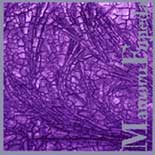 |
| I realize that this Tzadik release goes back many years. I was actually surprised to see that it was released in 1997. This means that I have been absorbing this recording for almost 30 years! Back in the time when we would tour with CD wallets, this CD was always there for me, along with a small handful of other music that I depended on as a sort of antidote to all the noise and mayhem, to reflect and instill a purity of purpose and inspiring aesthetics. I am not exaggerating when I say that "Patterns Of Plants" is one of my all-time favorite recordings. This music, performed variously on koto, sho, hitsu, viola de gamba, and harpsichord, apparently derived its melodies from scientific data on plants and from "generated surface-electric potential on leaves" (from the Tzadik website). Perhaps this accounts for its cogent and compelling use of space. The music takes its time. To me, it sounds like solitude that is not lonely. Its use of stringed instruments, tuned variously in just intonation and/or Pythagorean tuning, is pure heaven to my ears. The first four or five pieces are such favorites of mine that I sometimes just listen only to them, multiple times. Plainly stated, this music is BEAUTIFUL. Whether reflecting Asian musical traditions or that of Medieval Europe, it conjures contemplation. As I write this, I realize I even tried to get close to the sound and vibe of this music in a solo movement that is part of my piece "Rod Poole's Gradual Ascent To Heaven" (from my album Coward, 2009). Open-tuning a half-size acoustic guitar to what sounded like the right kind of out-of-tune (no Pythagorean or any other systematic tuning, sorry), I found some little themes and slowly improvised around them (you can hear the 2+ minutes from around 3:30...). Perhaps it's a rather thin approximation, but I was hoping I might manifest even 1/100th of "Patterns Of Plants'" haunting beauty. The magic spell it weaves seems inexhaustible. |
 |
JAY CAMPBELL recommends |
|
| SYZYGYS’ EYES ON GREEN – SYZYGYS LIVE AT TOKYO INKSTICK 1988 |
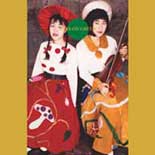 |
Syzygys is a Japanese organ/violin duo making delightfully bizarre pop music with Harry Partch's (unequally distributed) 43-note-per-octave scale, which I can really only describe as being musically tickled. There's something weirdly unnerving about this music: on one hand, you are experiencing precise mathematical fusions of harmonic alignments in whole-number ratios, but undergirded with grooves that sound like a pub karaoke machine. Musical styles are approximated, and then overlaid with completely insane lines of inscrutable intervals. Extremely goofy and incredible things happen in tracks like "Pastoral Cha Cha", opening with a chord containing what sounds to me like a deliberately wolfy 5th, before moving to a flat 6:7 septimal third, then launching into a microtonal-organ and violin dialogue over a bassline one might find at a wedding reception. Or like in "Bossa Nova!", some kind of acid-laced approximation of João Gilberto complete with relaxed vocal melodies (literally including the words "bossa nova" repeatedly) and playful xylophones, punctuated by seasick organ interjections that fully embrace the nearly-intolerable awkwardness of the neutral intervals contained within its pitch collection. Another thing I really like about this live recording, over their studio albums, is that not everything between violin and organ is perfectly in-tune when they are playing these tiny and unusual intervals together-- not only does it add even more disorientation to something already spectacularly confusing, but it really highlights how wildly challenging and bold it is to work with an interval collection like this, both technically and intellectually.
I like things with conceptual tensions...things that should be tearing things apart toward opposite directions, but somehow alchemise together into something really unexpected and new. There are moments all over this album-- totally carefree vocals over some nice chill grooves, and then out of nowhere the microtonal-organ might bust in like a goat that is vomiting up a child...but really in the most charming way imaginable, and all done without a single drop of any intellectual pretension. Somehow, it just all works. You'll probably laugh. Your toes might tap while your face puckers. You'll definitely wonder what the hell is going on. |
 |
MATT MITCHELL recommends |
|
| TETSU INOUE’S PSYCHO-ACOUSTIC and FRAGMENT DOTS |
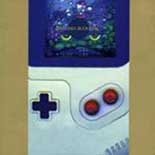 |
I bought Psycho-Acoustic in 1998 or 1999. I was 23, I was a new arrival to NYC, and I shopped regularly at Other Music and Downtown Music Gallery. I don’t remember exactly where I picked this up but it was almost for sure one of those two legendary places. Since it was 1998-99, the ability to hear literally any record ever before buying it wasn’t possible yet, and so I was still buying records on based on research and faith, and since I already knew I was into many Tzadik releases, I was very intrigued by the description on the spine: “This CD features some of the most intricate and fascinating computer generated compositions you've ever heard. Literally thousands of hours went into the creation of these miniature masterpieces charting a world of sound as yet explored.” I was on the cusp of being as obsessed with electronic music as I was with forward-thinking jazz, improvisation, “modern classical” music, and underground grindcore and metal.
I later learned that Tetsu Inoue was very important in the world of ambient music, but he was completely unknown to me at the time. Put in the CD and voila, instantly a “wow feeling” of something completely alien to me that I knew I immediately liked. I had no clue as to how this could have been made, but it absolutely reached me. “Thousands of hours” indeed! The entire disc, save the closing “Tom & Tone” jam with Ikue Mori (who I very soon learned was very much a precedent of sorts for this sort of music), is a vertiginous, kaleidoscopic procession of timbral virtuosity. It establishes its own contextual space for listening, something that all my favorite music does. A remarkable thing about this album and Inoue’s follow up Fragment Dots - a further growth and expansion within the same universe of Psycho-Acoustic - is that Inoue manages to achieve a total cohesion within the dizzying array of incessant formal switchbacks and cascading blurps and buzzes. Upon revisiting these albums recently, it now seems apparent that this is due to there being a foundational underpinning of musical fundamentals present in both of these records: every piece has a very particular formal outline, usually driven by groups of often interleaved and interwoven timbral sources; often-but-not-always-consonant pitch materials of varied derivation that tie everything together; and a vibrant rhythmic impetus driving the proceedings, often likely the result of beyond-savvy editing. The number of edits involved in this record is somewhat sweat-inducing to ponder. And yet, this music transcends mere (albeit wonderful) analytical listening and inspires all manner of extra-musical imagery for those so inclined; any sort of imagined sci-fi alien flora and fauna taxonomy would suffice.
During my recent revisitation with these albums, I marvel at the fact that they are *25 years old* on average. It is often said about older masterpieces, but they likely would be considered jaw-dropping if released today. In some respects, however, there is a visionary sort of bent to them that arguably still places them in the era in which they were made. Even though the ensuing quarter-decade of technology means that it is less time-consuming these days to get close to the sorts of sounds on these gems than it would have been in 1998, I still imagine there to be a sort of hermetic-like devotion to a slower pace of work that allows for this sort of detail, one that is probably a prerequisite for work such as this and one that transcends any era of aesthetic and artistic creation. But this *still* sounds very much forward thinking, even while celebrating elemental aspects of sound. |
 |
MATANA ROBERTS recommends |
|
| DEREK BAILEY’S STANDARDS |
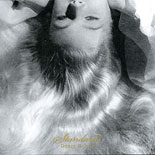 |
| So many amazing ones to choose from but one of my all time favorites is Derek Bailey's Standards—I have worn that record out over the years. It is a seminal album. Bailey's inventive improvisational style truly stretched the bounds of traditional forms. His distinctive takes on jazz standards—which he dissects and reassembles in his own way—are showcased so beautifully on the 2002 recording (released in 2007). I don't adhere to that conventional canon anymore, but my initial impression of this record was one of possibilities and transformation. Bailey's daring investigation of sound and his capacity to wring surprising melodies and textures out of well-known songs can be captivating and difficult at the same time. The record challenges the listener to actively participate, asking them to reevaluate their ideas about music and the limitations of improvisation. All in all, my initial experience with Standards was profound and made me reconsider what I thought I had already understood. |
 |
THERESA WONG recommends |
|
| MICHIYO YAGI’S SHIZUKU |
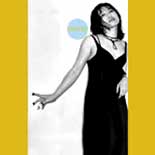 |
| Stepping into Michiyo Yagi’s world of Shizuki, I feel as if I've entered a paulownia forest bristling in shards of intermittent sunlight during a spring rainstorm. Both earthy and otherworldly, this album beautifully merges the ancient sounds of the traditional koto with Yagi’s personal vocabulary of unconventional techniques. The result is at once grounding and invigorating, familiar yet electrifying. By virtue of having moveable bridges, the koto lends itself to shape-shifting through different harmonic worlds. In this collection, some pieces touch upon traditional pentatonic harmony, while others morph into microtonal landscapes like Harry Partch on a turntable gone haywire. The hard-driving rhythms and visceral energy of Yagi’s teachers Tadao and Kazue Sawai are palpable, but the textural and emotional terrains are distinctly her own. A classic and gem in the Tzadik collection! |
 |
KRAMER recommends |
|
| JOHN ZORN’S THE HERMETIC ORGAN VOL 11—FOR TERRY RILEY |
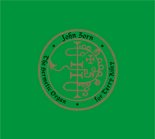 |
| When I want to feel (or fall) deeply into my formative years, I look to my own first Love, the Organ. It's the place where I found my voice before I had ever sung or composed a single note. The Organ is John's first Love, as well, and listening to him sculpt the air with such sheer force of sonic will, assures me that there is yet still something more to hear way out there in the yet uncharted wildernesses of sound poetics. John's work always bends the mind, and in this release - Volume 11 of his 'Hermetic Organ' series - he seems to be exploring the living breathing belly of the beast itself. An ocean of pipes are at his disposal, with a volume and frequency range light years beyond human imagination. Each installment of this organ series (first hitting me hard with Volume I, recorded in 2012) brings a new wave of awe to my heart, with his pulsating frontal assaults and rainbow-like reimagining of what a terrestrial body can create between molecules of air. John summons the heaving bellows in the crypt to expand and contract in submission to his genius, as I am caught wandering inside chord clusters, echoing in inversions yet always moving miraculously forward. The fact that he is improvising here only serves to amplify one's sense of amazement. This is the very spirit of jazz WRIT LARGE and comparable to no one else's work, yet i know that everyone from Nancarrow to Ives and back again to Cage and Stockhausen and to this piece's namesake, Terry Riley, would be left breathless and speechless in its wake. John Zorn, you are a lifeline to the most solemn introspections of each and every listener, and your fearlessness has been a beacon to me - a blazing lighthouse beam sweeping across the surfaces and the submerged depths of everything I have done in music The newborn chords you've hewn herein, and then the silences - YOUR silences... they leave me grateful not just for my ears, but for all of my senses. This kind of music works as catharsis for me, not being forced to climb a mountain of sound, but rather having it pushed through my very being as i stare up at it. This music is ALIVE. As Terry Riley created abstract fabrics of sound within beautiful repetitions, John's tribute here lies within his oneness with the organ itself, and his absolute 'All-In' belief in the medium, tearing down the walls between himself and the sounds he creates, until the two - the man, and his creation - are One. |
 |
BRIAN MARSELLA recommends |
|
| JOHN ZORN’S HEAVEN AND EARTH MAGICK |
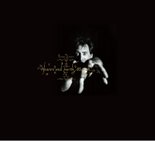 |
| This collection of 6 quartets for piano, vibraphone, bass, and drums represents some of my favorite writing of Zorn’s. It is music that I haven’t tired of, and that offers more with each listen. It showcases the new synthesis of two of John’s key worlds- completely notated contemporary classical writing with improvisation. In this quartet, the fully through-composed music is masterful performed by virtuosi Stephen Gosling (piano) and Sae Hashimoto (vibraphone). The improvising rhythm section consists of Ches Smith (drums) and Jorge Roeder (bass) - two musicians I know well, and full disclosure are two of my favorite musicians to play with. The result of the merging of these two worlds is mind-blowing to say the least. Putting the complexity of the music aside, what one hears is truly unique- I’ve never heard music like it. I feel in many ways, these quartets point to the the emerging future of music. They feel timeless, and yet so current. Obviously when one thinks of this instrumentation, we think of the Modern Jazz Quartet. But here, this feels like THE modern jazz quartet. Stephen and Sae are undoubtedly masters of their instruments and are the perfect interpreters of Zorn’s music. I feel they both thrive with this level of challenging music and it is so exciting to hear! And Ches and Jorge are beyond deep with their level of interpretation. This is the perfect balance of composer and musician- of course John writes FOR musicians and that is key - but the mix just feels so right with these compositions. The writing - from form, texture, and counterpoint is just off the chart and there are so many moments that I love, with times where you feel like you will lose your breath, and other moments that make you cry - like Jorge’s solo on Acéphale. I have heard these pieces numerous times live - and love how they continue to grow - but for those of you who haven’t yet heard them - this is an album you should consume. |
 |
MAKIGAMI KOICHI recommends |
|
| SYZYGYS’ COMPLETE STUDIO RECORDINGS |
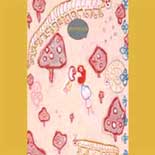 |
| This is a unique work in which a young Japanese woman, influenced by Harry Partch, created her own microtonal organ and attempted to create pop music. Their music is unique and deserves to be appreciated. |
 |
TOMAS FUJIWARA recommends |
|
| MILFORD GRAVES’ GRAND UNIFICATION |
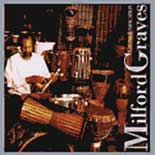 |
| I first heard Milford Graves on Albert Ayler’s “Love Cry,” when I was about 17 years old. As a young drummer seeking out the history of the music I loved, and always searching for fresh inspiration, I was immediately drawn in. From “Love Cry” I branched out to other albums featuring Milford Graves, such as The New York Art Quartet, The Giuseppi Logan Quartet, The Lowell Davidson Trio, and Paul Bley’s “Barrage." In 1998, when I saw that “Grand Unification,” his new solo album, was coming out, I picked up a copy right away. From the first seconds of his percussion and voice, I was captivated. I had entered the unique and personal creative and sonic world that is Milford Graves and I wanted to just stay there. Every listen gave me new perspective, new ideas, new questions. I had never heard anything like it before and haven’t heard anything like it since. The rhythms are clear and powerful, yet multidirectional and flexible. He is telling you a story, but he is also allowing each listener to draw their own story from what they are hearing. From the track Decisive Moments: “You say you play those drums? I want to hear them, boy. Can you do a roooooll? A rooooooooooooll—what is a rooooooooll? Well you just listen, my man!” |
 |
SYLVIE COURVOISIER recommends |
|
| JOHN ZORN’S THE TURNER ETUDES |
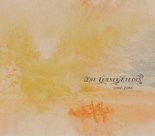 |
Embark on an extraordinary musical odyssey with "The Turner Etudes" by John Zorn, magnificently interpreted by the amazing pianist Stephen Gosling. This groundbreaking collection follows the legacy of Chopin and Ligeti ’s études, while boldly carving its path into uncharted territory, using the whole spectrum of the piano from Crumb’s extended technique to complex rhythmical systems.
Gosling's masterful interpretation breathes life into each étude, seamlessly navigating the intricate rhythms, daring harmonies, fast-event vibes and virtuosic passages that define Zorn's unique musical language, offering a glimpse into the boundless possibilities of contemporary piano music.
"The Turner Etudes" is the new legacy of piano études of the 21st century and a must for every pianist and piano lovers. |
 |
SIMON HANES recommends |
|
| GREAT JEWISH MUSIC: BURT BACHARACH |
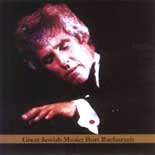 |
| As a Bacharach fanatic myself, I feel a strong sense of unity with the other musicians in the NYC downtown sphere who have been as deeply touched by the work of this incredible composer as I have. Naturally, an album like this—a collection of those very musicians paying homage to the great BB by running his music through their imaginative, inventive, sublime, occasionally warped musical filters—is right up my alley. The beauty of an album like this is how it affords the musicians involved an incredible opportunity to let their compositional personalities to shine through by stamping them onto Bacharach's compositions. The record is a testament to the vibrant musical energy which was flowing in NY's downtown in the mid-90s, as well as the incredible musical strength of BB's works—that they can be filtered through so many different compositional lenses and still remain undeniably, indefatigably, Burt. |
| PETER SCHERER’S CHRONOLOGIA |
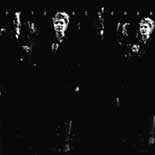 |
| A beautiful collection of pieces from Scherer's 90's film & dance production music. Atmospheric, eclectic, eerie and intense, Scherer creates a wholly unique sonic world that pulls the listener in through extreme craft and attention to detail. Scherer is a master of the artful juxtaposition of strange, unearthly tones & drones with acoustic samples & field recordings that ring a bell in our collective memory, though just softly enough that we can't quite place them. Bizarre rhythmic figures pass through the sonic field and we hear ominous, dread-inducing peals of thunder and clangs of metal in the far distance. The resultant combination of intensity, menace, and sublime delicacy is an absolute feast for the musical imagination. |
 |
JORGE ROEDER recommends |
|
| JOHN ZORN’S THE CIRCLE MAKER—ISSACHAR |
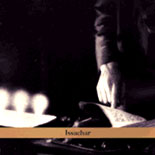 |
| Recorded in December 1997, the first part of this 2-CD album features the Masada String Trio, with Mark Feldman on violin, Erik Friedlander on cello, and Greg Cohen on bass. From the first listen, this record touched me, as the sounds coming from these three instruments were like nothing I had ever heard before. 20-some years later, it’s an absolute go-to for me - I played it more times than I can remember, and it keeps getting better the more I listen. String music at its absolute best—a level of sonic variety that displays the textural possibilities of these instruments. The level of interaction, blend of tones, sublimely masterful and soulful improvising skills on violin, cello and upright bass that are so rarely seen. They drive the rhythm with echoes of traditional drummer-less ensembles like a Tango orchestra or a Klezmer group, but with a forward thinking take. The Masada Book has proved time and time again that it can be beautifully interpreted in many different formats, and the Masada String Trio versions honor both the Book and the Trio in such a special way. This is a gem from beginning to end. |
 |
MARY HALVORSON recommends |
|
| MELT BANANA’S MXBX 1998 / 13,000 MILES AT LIGHT VELOCITY |
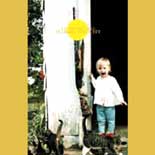 |
| Melt-Banana is a mind-bending band. The first time I heard them live was probably around the time of this release, and they've been a favorite of mine ever since. I guess they are normally categorized as noise rock, but it's impossible to put them in a genre. The insanity of their live performances is so well captured on this album. They somehow manage to combine complete recklessness with exacting precision, which is hard to pull off. There are so many moments here that are surprising and perfect. Gem after gem. Lightning fast changes, but never the ones you expect. It's super intense all the way through, and must be blasted at a high volume. The cover of Surfin' USA is just incredible. Highly recommended for a burst of energy and some creative inspiration! |
 |
MATT HOLLENBERG recommends |
|
| JOHN ZORN’S IN A CONVEX MIRROR |
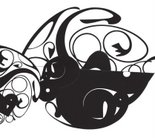 |
Within the sonic tapestry of In a Convex Mirror, the interplay between John Zorn's saxophone and Ches Smith's percussion transcends mere music, delving deep into the realms of instinctual lucidity and translucent energy. Like ancient shamans invoking ancestral spirits, they conjure primordial polyrhythms and unfettered imagination, weaving a narrative that blurs the lines between past and future.
As the music unfolds, one can’t help but feel that we're traversing through the corridors of the subconscious—a Dionysian journey where ecstatic threads intertwine with ominous undertones, creating a landscape both mystical and mysterious. Zorn's saxophone cries out with primal urgency, while Smith's percussion beats like the pulse of the Earth itself, guiding us through harmonic interactions that resonate with both familiarity and strangeness in their elemental power.
The opening track emerges like a primal scream—a cathartic release that clears the path for the ecstatic celebration. Each track on the album is a chapter in this sonic odyssey, from introspective reflections to ecstatic celebrations. In Through a Glass, Darkly, moments of serenity give way to bursts of madness, as the music shifts seamlessly between delicate balladry and explosive improvisation. In Le Tourbillon, the percussion takes on a life of its own, its rhythms crashing and rolling over itself like waves, propelling us forward into the unknown. Moments of tranquility give way to bursts of frenetic energy, as the musicians navigate through a labyrinth of emotions and textures. Amidst the seeming chaos, there is sublime beauty—in the haunting melodies of Zorn's saxophone, in the delicate and eerie harmonies of the Fender Rhodes. Together, they create a soundscape that is at once terrifying and transcendent, inviting us to explore the depths of emotion.
And as the final notes fade into silence, we are left with a sense of wonder—a feeling that we have glimpsed something truly extraordinary. In a Convex Mirror is not merely an album; it is a journey—a journey into the heart of sound and the subconscious itself, where beauty and chaos intertwine in a symphony of sublime ecstasy. |
 |
CHES SMITH recommends |
|
| JOSE MACEDA’S DRONE AND MELODY |
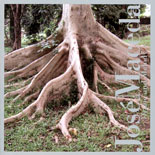 |
In 2000 composer, ethnomusicologist, and pianist José Maceda was engaged in a residency at Mills College in Oakland California. I was in the percussion section of the Contemporary Performance Ensemble for his concert, playing “buzzer” (a piece of bamboo with slits cut in it that buzz and rattle when struck) on his piece ‘Strata.’ The music sounds very free when you hear it, although it is in fact firmly in time, with complex layers of interlocking polyrhythms spread throughout an ensemble densely populated with percussion, flutes, cellos and guitars. The piece was difficult for our ensemble, which was mixed in terms of musicianship and experience, and we were flailing a bit. Luckily, Willie Winant showed up to demonstrate exactly what was to happen where and drill us (unrelentingly) till we were all playing the rhythms accurately. A full rehearsal was dedicated to this, and it did the trick.
During the performance I was so focused on my part, and counting so hard, that much of the beauty of ‘Strata’ was lost on me. With the release of the recorded performance on the album, I hear a totally unique sound world of juxtaposed layers of instrumental groupings from Philippine and western concert music traditions. Loosely repetitious lines develop independently, creating a long-from counterpoint that defers its hookups until strategic points. As soon as you begin to hear each part as completely independent, another landing occurs, revealing ways in which the lines are conjoined. The end of the piece is a culmination of sorts, yet it arrives at a place very far from the beginning.
I also played on the piece ‘Music for Two Pianos and Four Percussion Groups’ recorded several years later. It too operates in terms of juxtaposition: clouds of multi-tempi shapes linger, then disappear into blank space exposing percussion polyrhythms that destabilize the silence that follows. There are several hand-offs of melodic and rhythmic material between the piano and percussion, each one unexpected, developing the music by thinning it out, eliciting a fresh view of how the piece operates. The meticulously orchestrated percussion (almost entirely traditional western instruments here) works with the piano in a way that is as compelling as it is hard to describe. Each instrument occupies a registral and timbral space, yet at times a tambourine or a woodblock will blend with the high register of the piano, enveloping it in the percussion or augmenting the piano’s range. It is a new purpose for commonly used instruments.
I can hear Willie’s rich and complex tone throughout. In fact, I can hear it from all of us—that was and is mandatory from his students and everyone he plays with. |
 |
SEAN ONO LENNON recommends |
|
| YUKA HONDA’S MEMORIES ARE MY ONLY WITNESS |
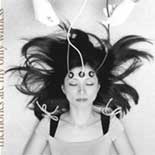 |
I consider myself extremely lucky to say that I have been playing music with Yuka Honda in one form or another since we met in New York in the mid '90s. Before I joined her band, Cibo Matto, they were to me the very nucleus of what was cool about the music scene. Yuka taught me many things about writing and production over the years. The first time I ever read a chart was at her behest for a recording she produced of Aguas De Marco featuring musicians like Marc Ribot and Dougie Bowne. I was totally out of my league, but Yuka gave me the confidence to hang with people I considered to be legends.
Fast forward to 2002, Yuka released her first solo record, Memories Are My Only Witness, on Tzadik–an album that I consider to be a classic. Yuka’s musical perspective had been evolving through years of touring and recording with people all over the world. She had already been the archetypal, ‘musician’s musician.’ Everyone from John Zorn, to Mitchell Froom, to the Beastie Boys considered her to be a cultural leader.
She is known as a sampling guru, but not everyone understands the true scope of her gifts. Memories Are My Only Witness is like opening up a window directly into her heart, and peering inside. Unfettered by any pressures to be pop, or to satisfy a major label, Tzadik provided her with an opportunity to simply make the music she wanted to make.
Although the record has many bangers, (I recommend dancing alone with a glass of wine and some tissues), my favorite songs are the most restrained. Small Circular Motions and The Last One to Fall Asleep are both heartbreakers. They feature some of Yuka’s most musically generous instincts: playful sophistication combined with sublime simplicity. This is a record I have returned to again and again over the years, and it only gets better. |
 |
MILES OKAZAKI recommends |
|
| DEREK BAILEY’S CARPAL TUNNEL |
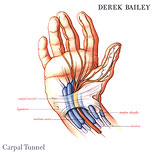 |
On Derek Bailey's most well known recordings, he gives the listener the impression of an effortless flow around the guitar, navigating the surface of the strings with the detail and grace of a master calligraphist. The dance of his hands along the full range of the instrument could produce sonic events that turn on a dime between sharp exclamations, fluttering brushstrokes, cacophonous rhythmic pummeling and heavenly cries. There is great humor mixed with deadly serious commitment to the performance, all executed with an astonishing technical control of the instrument.
But on Bailey's final recording Carpal Tunnel we hear him in the context of struggle, as he confronts the onset of the condition that would take his life only four months after the release of the album. He has lost the ability to hold the plectrum to produce his signature pointed articulation, playing instead with the raw sound of bare fingers and nails. Each utterance is vulnerable, soulful, and filled with the intent of a man wrestling with the physicality of the task at hand. The first track, Explanation and Thanks, is a self-accompanied Bailey monologue, sparse and confessional. While searching for his signature harmonic tintinnabulations, he says, "when I consult medical people about this, they all say I should have an operation, but I'm more interested in trying to find a way around it." Over the course of five tracks, he journals twelve weeks of his progress trying to find this way, giving the listener a heartbreaking and revealing look into the mind of one of the great improvisers of all time. |
 |
CRAIG TABORN recommends |
|
| BILL LASWELL’S INVISIBLE DESIGN |
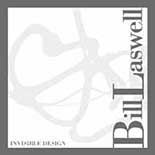 |
Bill Laswell has been one of my favorite musicians. He is a fantastic bassist, producer, and inspired musical conceptualist whose work often involves organizing contexts for creative musicians from various musical approaches to collaborate. The range and diversity of his musical projects are breathtaking, and his curatorial sensibility and concept of formal organization are the glue for these projects.
I love his solo album Invisible Design, which documents Laswell’s sensibilities focused inward. It features bass as the main instrument to create vast soundscapes from a refined sonic palette. The music moves through dark ambient textures, prepared and extended bass techniques, lyrical melodies, and the deep essential grooves that are a hallmark of his sound.
Bill Laswell has made so many fantastic recordings, leading and collaborating with amazing musicians. Still, for its unique, unadulterated glimpse into his musical mind, I treasure this deeply personal album, which is a masterpiece of the solo album form. |
 |
TYSHAWN SOREY recommends |
|
| DEREK BAILEY/JAMAALADEEN TACUMA/CALVIN WESTON’S MIRAKLE |
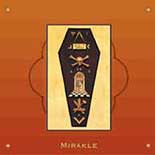 |
| The title of this masterpiece of an album couldn’t be more apt, not least when one considers the lineup of my lifetime heroes in the world of spontaneous composition, but also the magnificent results of what happens when these three musicians – all of whom individually possess a very strong, unique aesthetic and approach to their respective instruments – gather and make music for the first time. Without discussing any musical detail about what is going on in this guitar trio’s magnum opus, I will just say that if Derek Bailey is in the center of any creative situation and given the preciseness of his approach to spontaneity (coupled, of course, with his sui generis language on the guitar), there is always going to be room for anything to happen. The same holds true for Jamaladeen Tacuma and Grant Calvin Weston on their instruments. The communication between these three is in its most natural form here; it is a musical landscape that is at once surreal, confrontational, fun, and all encompassing. Everything that this group plays is a dance, and all three players’ musical vocabularies are always coherently juxtaposed against each other in the most refreshing – and sometimes hilarious – ways imaginable. It just WORKS. It is undoubtedly one of the most inspiring recordings I have ever heard in my life. And for those who are fans of Bailey, Tacuma, and Weston, know that after listening to this album you have just experienced three artists from different musical worlds who made music that is completely in and out of this world. |
 |
JOHN MEDESKI recommends |
|
| JOHN ZORN’S OLYMPIAD VOL 2: FENCING 1978 |
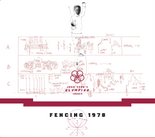 |
I love this record. I find myself listening to it a lot. When I’m in the car driving somewhere (which is always where I live) it’s what I land on more often than not. It’s an incredible snapshot of a certain moment in time. Field recordings have always been a deep inspiration for me, from all cultures. To feel through the language of music the energy and spirit of a point in history before anything and everything was available all the time can help access deep parts of ourselves and the source of creativity.
This recording happened in 1978!! I think about what the hits on mainstream radio were that year: Stayin’ Alive, You Light Up My Life, Just The Way You Are, We Will Rock You, Last Dance, Come Sail Away, (there are so many more), and I give the deepest thanks to everyone who made THIS recording of Fencing possible. Like the monks that spend their lives praying on the top of the mountain for all of humanity while the world swirls in material bullshit, John Zorn, these musicians, and the whole scene back then were doing something so vital to the evolution and survival of human creativity.
Exploring and expanding the nature of composition and improvisation, challenging the meaning of form and melody, and inventing new opportunities for freedom to be expressed, the music on JOHN ZORN’S OLYMPIAD VOL 2: FENCING 1978 takes me where I personally like to go. Somewhere I can completely let go and just be immersed in a sonic event, not analyzing or understanding, not feeling comfortable in some nostalgic familiar musical bubble bath, not safe in an intellectual arm chair, but somewhere I have no choice but to free fall and just experience, knowing and sensing the underlying structure that is so clearly there being realized by amazing musicians guided by a master composer-visionary. AND there are 2 different performances of the piece showing a tiny glimpse of the infinite universe music like this can explore. |
 |
WENDY EISENBERG recommends |
|
| MILFORD GRAVES’ STORIES |
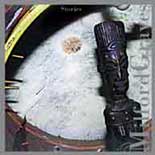 |
| Every life that is music, every morning and evening of the world, crystalline. Usually when I read stuff like that about records I think people are exaggerating but every time I take in this record I am so moved by the honesty and completeness and the capacity for music to heal and to be fully expressed that I realize that hyperbole can sometimes actually be a psychic underlining technique. This music emerges like a heart, from the heart, a full expression, perennially sounded. I was trying to think about how to talk about the first time I heard it, but it feels so true that maybe the first time I heard it was when it was played - the recording is that faithful, it excavates time, rendering it transparent and reflective, like a crystal. |
| CARLA KIHLSTEDT'S TWO FOOT YARD |
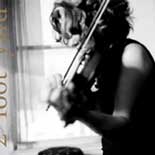 |
| One of my all-time favorite songwriters, playing the coolest songs in the world with Marika Hughes and Shahzad Ismaily. Super inventive forms, honest and exploratory lyrics sung incredibly beautifully with such a specific and touching quality of breath. All of my favorite music feels resourceful like this - from Milford Graves to Tetsuo Inoue to the B-52s, I like hearing people stretch out, crack their knuckles, figure out what they can do with who they are and what they have around. While songs like these would work really well in a more conventional "rock band" setting, the shifting orchestration styles and arrangements make this record sound so homegrown like that, experimental in the sense "how can we do this" rather than experimental in any genre-'d way. Way too overlooked, always interesting and satisfying, highest recommendation to anyone curious about what beautiful and unexpected things the epigrammatic nature of song-form can express. |
 |
TIM KEIPER recommends |
|
| LES RHINOCEROS |
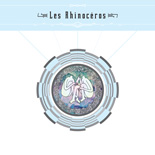 |
\Wow, these guys are my new favorite band.
Les Rhinoceros, brainchild of bassist and composer Michael Coltun, presents some of the most exciting music I've heard in a long time. But don't get me wrong- this is a BAND, and the contribution that Peter Tran and Tom Klecker bring to the music is significant and immediately apparent. This is the sound of a band that really cares
about the music.
This is not only the first recording of Les Rhinoceros, but it is also these musicians' first band. One might say that these circumstances really highlight their potential. But these guys don't need potential. They already totally rock with urgency. Yet I think what's truly remarkable here is that when you catch musicians at the
beginning of their musical lives, you can capture the creative spirit in its most pure form. These musicians are having their initial creative experience together and that's what's so striking about this music: it is absolute, raw, and wholly real.
This is contemporary creative music of the youth in the 3rd millennium. They have found a way to synthesize the vast musical landscape of their influences and present it as something coherent, unique, and sincere. It is meaningless to dissect all of the individual elements- rock grooves mixed with world grooves, cinematic
melodies alongside ambient noise, etc. -- because this album plays out as a continuous journey you can listen to from beginning to end, and ultimately, it's just really good music. |
 |
SCOTT JOHNSON recommends |
|
| MICK BARR'S IOHARGH WENDED |
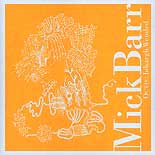 |
I’m going to abandon my paper composer tribe for a moment, in favor of my first clan: electric guitar players who imagine more complex or unpredictable music for their instrument than the pop that gave it birth. In the absence of any well-beaten paths to this goal, a few just start walking.
On the surface Barr’s solo pieces are pure, technically heroic metal guitar, with or without a cleverly synchronized and relentlessly driving drum machine. Phrasing and pattern are everything here, but his patterns seem to delight more in interruption than in continuity or logical progression. The fun lies not in how this phrase develops from the last one, but how it contradicts. I imagine that I hear echoes of Zorn’s jump-cut editing, or the tautly executed illogic of Captain Beefheart, as much as any steady minimalist continuum.
As I understand it, these pieces are neither notated nor improvised -- they are memorized while under construction. There’s a reminder here for composer-world: scores are incredibly useful for creating and communicating large amounts of information to large numbers of people, but they are only a tool. They are not the only way to generate creatively complex or experimental music -- just a particularly efficient and reproducible one. Barr’s pieces aren’t especially concerned with one of the primary interests of most score-based composers: contrast, whether in mood, tempo, timbre, harmony, emotional connotation, or transition between contrasting areas. Here it’s about short-term contrast between rapid-fire gestures, each at the same mad tempo and intensity. It induces a string of momentary chunks of consciousness, and although this music has little to do with the abstractions of High Modernism, there is a similar absence of all that is warm and fuzzy. But despite my occasional musical forays into the warm and fuzzy, my ear was immediately grabbed by this collision of urgent metal sounds within an atomized continuity. |
 |
JESSICA PAVONE recommends |
|
| EYVIND KANG'S STORY OF ICELAND |
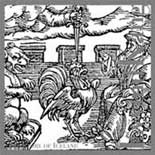 |
Evynd Kang initially stood out to me for the unique and effortless sounding quality of his viola playing. His lucid style, sliding through whole melodies on one string, senza vibrato, sometimes reminiscent of a bamboo flute is both distinct and stunning. But it wasn't only his trademark sound that drew me into this record; it was the conciseness of the compositional structure, mirroring the same brilliance as his approach to the viola.
Efficient with his sound pallet, Kang crafts a wealth of artistry with only a few pointed and deliberate repeating musical motives. Deceptively simple at times, a more penetrating listen reveals an underworld of textural richness. It requires the listener to not only listen to this record, but live in it. |
 |
WAYNE HORVITZ recommends |
|
| JULIUS HEMPHILL'S ONE ATMOSPHERE |
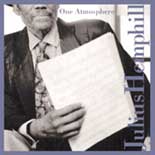 |
One Atmosphere is a posthumous recording that highlights three distinct facets of Hemphill’s work as a composer, although on close listening the unity of all the music is far greater than any superficial distinctions in style, instrumentation or compositional approach. Savannah Suite, featuring Marty Ehrlich, Erik Friedlander, and Pheeroan Aklaff is probably closest to the spirit of what we imagine many of Julius’s collaborations and concerts would have sounded like in the years he worked in St Louis and later in New York and around the world, especially in light of his long standing association with cellist Abdul Wadud.
The works for sax quartet and sextet, entitled Water Music for Woodwinds I, II, III and IV are beautifully written and just as beautifully played. Nods to Ellington and Strayhorn emerge within Julius’s distinctive harmonic language, with gorgeous melodies often offset by strange and delicate harmonic motions.
The centerpiece of the CD for me, unexpectedly, is Julius’ stunning work for String Quartet and Piano, One Atmosphere, with his long time life partner Ursula Oppens on piano. Julius avoids all the pitfalls of so called “jazz” composers writing a piece for classically trained musicians, and at the same time stays true to his personal language harmonically, rhythmically and texturally. The cliché is unavoidable, but what we regret most hearing this piece is simply that Hemphill didn’t have the chance to write many more, the music world would have been all the richer if he had.
Produced by Marty Ehrlich, a long time friend and musical partner of Mr. Hemphill’s. |
 |
JOHN OSWALD recommends |
|
| JOHN ZORN'S HOCKEY |
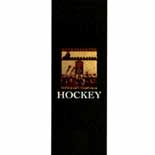 |
I'm a singles man. I used to be an album kid. From the mid-'60's through to the early '70s i accumulated a few thousand of these 12-inch black circles in square packages. During the same time i purchased at most half a dozen of the 7-inch 45 rpm versions that were often called 'singles' (even though they inevitably featured a total of two audio emanations, one on each side). An album could be a thoughtless assemblage of singles in an arbitrary picture sleeve; but the ones i gravitated to were examples of novel ways one could navigate a listening experience in two circa-20-minute audible episodes, extractable from an image-and-text festooned envelope, an intriguing visual and literary foil to its soniferic contents. And although one could listen to designated portions of these .3 hour continuums by dropping the needle at the visible widening of the groove that indicates the usually quiet time-furrow between 'tracks', in my subterranean listening burrow i most often auditioned a side from it's outer edge all the way through to its inner lock-groove. I may be wrong about this last memory; I'd like to think i may have been more often in pre-plunderphonic needle-drop and jump mode back in those adolescent and teen years. But eventually i was separated from my record collection, and leisurely side-long listening became more of a rare luxury.
In 1974 with my dad's Air Force dufflebag, an alto sax, and no records, i moved 4,000 miles to the west coast of North Am. I was spending time at one university, but quickly discovered that the equivalent institution at the other end of town had a much more accessible and extensive Recordings Library. It was set up like a record store, with accessible bins of thousands of discs; the difference being that none were shrink wrapped. I could often be seen carrying a stack of these, from down stretched arms to chin, to a phonograph and headphones kiosk, where i would sample each slice of this buffet tower, often spending no more than ten seconds per track.
In subsequent years as i began to travel, and crash with musicians, many of whom were endowed with massive disc libraries of their own, i was in the habit of making needle drop compilation cassettes of the more rare and obscure corners of their collections. I'd become accustomed to listening to music in short bursts. Pop music, where the content of the average recorded song is approximately 80% redundant, was somewhat engaging in those ads of segues of all the songs on the album — i tended to apply that presentation modality to all types of music. It was a rare track that escaped being abridged by my impatient cueing.
Then there was John Zorn's Hockey. I suspect we all instinctively ascribe some of the attributes of the particular titular sport to Zorn's game pieces, Lacrosse, Archery, Pool, etc., whether or not we know anything about what the score specifies. And so it is with me and Hockey. The way that i hear it, there's a silent puck which gets passed from player to player. What we hear is the shot the player makes. This takes the time it takes for the pass receiver to deflect the puck to the next player, dependent upon their reflexes and the type of shot they make. Each player seems to have a small vocabulary of shots: wrist, slap, backhand(?). By using these they can keep the puck in motion. Sometimes there is a sort of scrimmage where two musicians go after the puck at once. This is all in reference to the documented acoustic versions of Hockey, as performed by Zorn (reeds, who sometimes sounds like he's handling two sticks simultaneously), Polly Bradfield (fiddle) and Mark Miller (hit things). I haven't listened to the electric versions since i got the vinyl Pool (Hockey is the b-side composition on that album) 30 years ago.
As the reader will have already gathered, the present review is a self-centered rather than a researched and informed appraisal. I have never seen the score (Zorn copied tiny scores back then, sometimes postage-stamp-sized, which made even the youthful musicians who played them squint and therefore may have made the music seem more scholarly and serious). I have not bought the Tzadik CD (not that i recommend that anyone else should not buy the CD) and therefore I'm deprived of whatever elucidating program notes that container might contain, as well as the always satisfying packaging of Tzadik projects, but i find that i no longer stare at the visual components of an album while listening. (If you don't care about the packaging and haven't or won't purchase the CD may i recommend buying a few Hockey tracks as singles from an on-line record store…) And Hockey fits so well into my casual listening universe, which in recent years has been reinvigorated at first by fairly indiscriminate p2p downloading (an activity, that, contrary to the accusations of the music industry, led to a dramatic increase in my CD purchases) and then random-access playback on digital devices. Just this morning, in the hotel room where i write this, where i have plugged into the provided clock radio the gadget i use mostly to photograph and video with, it has randomly selected, following a recording of Kyle Shobe, 2010 World Livestock Auctioneer Champion and preceding Mead Lux Lewis' Whistlin' Blues, Hockey take 12. It's a wonderful juxtaposition, as the Hockey crosschecks inevitably are — the various takes of Hockey are amongst the champs in my collection for providing excellent surprise and satisfying contrast to whatever they are sandwiched between.
They are perfect singles, little symphonies for this elderly kid. |
 |
FRED FRITH recommends |
|
| ZEENA PARKINS' NECKLACE |
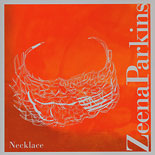 |
| I sometimes feel that Zeena’s wide-ranging skills and charisma as a performer have tended to obscure her work as a composer. It’s a pity, because she’s nothing if not compelling in that regard. Necklace is a typical example – abrasive and yet lyrical, beautifully crafted, meticulously realized, full of odd twists and turns, in fact—let’s face it—a little bit nutty, it functions as a fabulous soundtrack with no need for a film. I love its eccentricity, its not-too-high-modernism, its humor and its secret passion. No-one else writes music like this. Brava! |
 |
JOEL RUBIN recommends |
|
| TAFILLALT |
 |
| I first heard the wonderful Israeli trio, Tafillalt (Yair Harel, Nori Jacoby and Yonatan Niv), under the most difficult of listening conditions. The group had been invited to perform for a group of ethnomusicologists and musicologists during lunch at the World Congress of Jewish Studies at the Hebrew University in Jerusalem in summer 2009. The “concert hall” was a classroom at the university, with the usual fluorescent lighting, uncomfortable chairs, etc. Not knowing anything about the group, I luckily decided to stick around to hear them. Within seconds of their hour-long performance, I was mesmerized by a unique improvising ensemble performing their original music at a very high level. While the music was clearly based to an extent on traditional sources from various Sephardic, Mizrahi and Ashkenazic communities, the performer-composers had clearly assimilated ideas from all of these traditions to come up with something quite new and beautiful. I was particularly struck by the tightness of the ensemble, with Yair Harel’s voice fully integrated with the other instruments (primarily viola and cello, with other stringed instruments and percussion), and the wide range of expression that they achieve with a relatively small group. Afterward, I discovered that the group had released this wonderful CD on Tzadik in 2009. Listening to the CD has only deepened my appreciation for the group. The recording represents a tremendous variety, drawing especially on prayer and mystical poetic texts from 12th to the 16th centuries, but also from well-known modern secular poetry and other sources. The music – whether newly composed by the band members or from traditional sources – is always imaginatively arranged and performed in a manner that references traditional performance practice, but sounds fresh and new. Highly recommended! |
 |
GERRY HEMINGWAY recommends |
|
| RAZ MESINAI'S RESURRECTION FOR GOATSKINS |
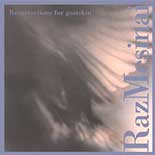 |
I have Ned Rothenberg to thank for turning me on to this CD and by way of it to the music of Raz Mesinai who is featured on this recording primarily as a solo performer combining a wide orchestration of percussive language and an understated and effective use of electronics. I am always particularly interested to hear percussionists who display the width of their expressive palette through the medium of solo performance. Raz has refined a unique vocabulary that along with his audio chops brings us deeply into timbre, overtones and resonances of the large tambours he features on this recording.
It seems Raz shares an interest I have with structuring his music on narrative models and he deepens that experience with a wonderful sense of place in his pieces. Adding as well a sense of ritual the opening piece, “Blind Owl” played on the Persian Zarb drum, rattles us into focus with its energy, dense rhythms and virtuosic use of color. On the second work “Sacred Warrior”, he brings the wind in with a combination of electronics (or mutitracking) combined with a Middle Eastern flute. The Mazhar frame drum, which includes jingles, appears halfway through and the instrument is powerfully recorded and sonically rich in transience as well as the skin’s resonances.
The featured work is certainly the title piece structured in four parts and moving ritualistically through various transformations, which flow and keep me continually entranced. It uses a variety of frame drums and an orcestral use of electronics to enhance the audio experience. Book ending this 15-minute work are two quartet works which sound scored for improvisers. They are not arbitrary but clearly mapped and formally specific again in a kind of narrative way.
Totally worthwhile listening and a wonderful musical and audio experience. |
| BILLY MARTIN'S STARLINGS |
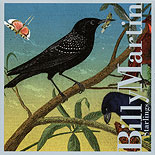 |
This 2006 recording of chamber music by percussionist/drummer/composer Billy Martin unfolds (if you ignore the liner notes on first listen) as a series of mysterious related miniatures, sometimes suggesting a hint of Stravinsky, Messiaen and reminding me rhythmically a bit of the dance music works of Steve Martland. With little registral movement the works are decidedly minimal in what sounds at first like repetition but in fact offers constant variation, kind of like excerpts of Beckett leaving one slightly bewildered but intrigued as to what happens next. I also hear immediately a relationship to the natural world, and the conveyance of nature’s rhythms resembles something akin to a summer’s night. And that is one of the reasons the recording works as a listening experience; it flows like a familiar river, slowly revealing its subtle nature in the three instrumentations that we cycle through twice, wind ensemble, percussion ensemble and string quartet.
It is nice to hear Anthony Coleman’s deft orchestration of Billy’s musical source point, which is only revealed on the final piece of the recording, when Billy himself performs on the instrument that acts as his main conduit to shape these formal musical works. And partially through the limitations this instrument possesses the musical ideas find clarity and a power to hypnotize our ears.
The recording has an overall lyrical form with the most energetic work, “Stridulation for the Good Luck Feast” preceding a slowly unfolding and more expansively melodic string quartet, “Strangulation” before the closing performance by Billy himself. These two works in sequence also suggest a life/death cycle, again in coherence with a strong resonance of the natural world.
I highly recommend this CD as a very unique and engaging listening experience. |
 |
TOBY DRIVER recommends |
|
| MARIO DIAZ DE LEON - ENTER HOUSES OF |
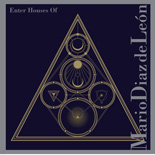 |
| This is one of those rare "flawless" albums that only come around once every few years and immediately reserve a spot in your future "best anything of anytime" lists (if you're the list-making type - I'm not). One of the most striking features of the music as a whole is its ability to sound simultaneously extremely chaotic and extremely clean and ordered. I mean "chaotic" here in the literal sense, in that the composer is using traditionally unpredictable elements such as noise, blown-out distortion, analog delays, etc., creating an organic chaos much different from the simulated chaos of the modern masters of concert music. All the while - with violins, ride cymbals, and flutes - the music is breathtakingly meticulous in having the architecture of a geometric hallucination, where every broken sound unfolds into a stained-glass-leafed tree branch, bearing fruit of impeccably faceted crystal skulls encrusting an inverted tourmaline pyramid on a moon of Saturn. This record greatly appeals to a respect for contemporary electric aggression (and succeeds because of its authenticity) as a backdrop for our apotheotic tendencies. I'm recommending this CD especially because I feel that Mario shares my own aesthetic, although I cry into my pillow each night wishing I could write music like this. Mario reaches polar extremes that are still beyond me.... the tremolo climax of "2.20" for example - one of the loudest moments on the CD - is one of the quietest sections of music I have ever heard. Fans of my own work are likely to really click with this recording and feel an awakening because of it. |
 |
MIKE PATTON recommends |
|
| YASUNAO TONE'S SOLO FOR WOUNDED CD |
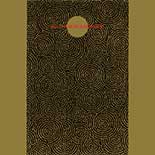 |
| A fascinating sonic experiment for a 'de-controlled' CD player, using a prepared compact disc which has been genetically altered to produce digital errors and artifacts during playback. Although the CD is 'wounded', the sound palette is colorful and vibrant---and the chance operation aesthetic escorts the listener on a seemingly out of control yet strangely intimate journey. A veteran of the Fluxus movement, Tone has taken the very tools and technological mediums we use on a daily basis and transformed them into chaotic and unpredictable music makers... wonderfully damaged instruments speaking a language all their own! |
 |
GEORGE LEWIS recommends |
|
| IKUE MORI'S LABYRINTH |
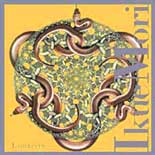 |
I’ve found myself listening to this recording again and again--at first, admittedly, with the goal of surreptitiously cribbing a few hot licks. After all, much of the West’s popular culture seems repurposed anyway (my son recently became part of a new generation of Yogi Bear fans), and imitation is no longer a real issue, not even in jazz, where sonic theft had once been anathema.
In the old days, it was said that bad composers imitated and good composers simply stole; you wanted to be one of the good ones, of course, so you would pilfer from the other good ones—say, from Le Sacre if you thought you could get away with playing the Robert Frost card:
Whose woods these are I think I know.
His house is in the village, though;
He will not see me stopping here…etc.
The old rule was that influence was a given, but if you were going to actually steal something, you had to disguise it—a practice repurposed by the hip-hop generation under pressure from corporate megamedia, whose manifestly unfair recording contracts paved the way for its spurious ownership of a fair subset of our world’s sonic histories, as well as the ability to reach into our mobile devices and censor our “record” collections at will—didn’t you realize what “digital millennium” really meant?
Certainly we knew that the work of certain composers couldn’t be nicked without detection and subsequent disapprobation—notably, Thelonious Monk. And so it proved with Ikue Mori, who begins by repurposing some of the primordial sounds of the early synthesizer era--what people relatively immune to irony regard as “the natural sound of the machine,” or what my late grandfather once called “the things we used to hear when we were fixing radios.”
Ikue’s music on this recording seems infinitely malleable in quiet and covert ways—the quick and unexpected changes of mood and texture; the absence of conventional cadences and soft landings; the imagined rituals and folklore, the suspenseful travelogues and trances; the delicately broken pulses, never far from her love of drumming, that suddenly emerge into multiorchestral complexity and richness.
Pandora’s Ikue Mori Radio may well include her tracks only--“sounds like…hmmm…NOT FOUND.” Repurposing the machine only to confound it somehow reveals a more direct way of negotiating the labyrinth of identity. |
 |
BASYA SCHECHTER recommends |
|
| BANQUET OF THE SPIRITS' CAYM |
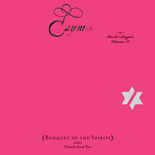 |
| In this latest iteration of armchair travel, "Caym" offers an ethnomusicological adventure through time and space for listeners who can't afford to jet set around the world. Featuring the exotic and pulsating rhythmic textures of Cyro Baptista and the adrenaline-fueled sound of "Banquet of the Spirits" - oud/bassist Shanir Ezra Blumenkranz, drummer Tim Keiper, and keyboardist Brian Marsella evoke foreign landscapes and cultures both ancient and modern in one of the most compelling installments of John Zorn's Book of Angels series. In this cd, think of the Arabic oud as the traveler moving fluidly between songs while Zorn's expertly crafted compositions serve as the map. The seductive sounds of Balinese gamelan rituals, Morrocan desert chants, and Oaxaca organ ceremonies intersect with infectious Brazilian tropicalia beats and the kinetic energy of Bhangra dancehall in this wildly eclectic program. From swanky Egyptian supper club swing to free jazz, Italian film music to favella gangster grooves, this record will unquestionably seduce those sonic adventurers in search of the unpredictable. Masterfully produced and arranged by Shanir Ezra Blumenkranz, "Caym" is anchored by the mystical expansiveness inherent in the ever enchanting Masada songbook. As with some of the greatest cities in the world, each visit to this record yields new treasures. |
 |
URI CAINE recommends |
|
| JOHN ZORN"S APORIAS |
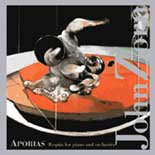 |
| I bought Aporias in 2000 and it knocked me out when I first heard it, At first I was drawn to the virtuosity of the piano part which was brilliantly played by pianist Stephen Drury. But as I listened again and again I began to appreciate the wonderful orchestration and the many different sound worlds that John Zorn conjures up in this piece. Aporias consists of 10 short pieces,each between 45 seconds and 4 minutes long. Dennis Russell Davies conducts the the American Composers Orchestra and 6 boy sopranos from the Hungarian Radio Children's Choir augment the cast. The cd was.released in 1998. The various movements present a variety of approaches to form. Some of the pieces feature quick changes in style, hectic moments and great dynamic contrasts. Other pieces feature quiet and sustained music. And although a lot of the pieces feature the piano in a concerto-like opposition to the orchestra, some of the pieces have little or no piano at all. John writes great beginnings (the haunting children’s voices that begin Con Mistero; the dramatic opening brass fanfares of Religioso; the hazy and distant strings that begin Postlude) and great endings as well (the bells, gongs and distant strings that end Impetuoso; the simple consonant piano chords that conclude Dramatico; the pulsating harp and high strings that fade out in Postlude). The orchestration is imaginative and subtle and Zorn has a great ear for unexpected sound combinations and juxtapositions. The orchestra is often employed as a chamber group. The percussion sounds (both loud and soft) add a lot to the music. I love the combination of the children’s voices with scraped percussion and celeste and the haunting and eerie string effects coupled with percussion in Freddamente. I also love Risentito with the pianist soloing against the flamenco-like handclapping percussionists, sounding like a cross between Eddie Palmieri and Stockhausen. There is a lot of humor in the contrasting musical moments but also a great freedom of expression and emotion and an open minded approach to many different musics. John dedicated this “Requia for piano and orchestra” to all artists, explaining that the title of the piece Aporias (aporias means an “impossible passage”) refers to those passages that separate life from death. I highly recommend this cd - check this music out and you will discover a truly remarkable piece played by great musicians and written by a composer at the top of his game. |
 |
MICK BARR recommends |
|
| RUINS' HYDEROMASTGRONINGEM |
 |
| Ruins blew my mind the first time I heard them. It sounded completely alien. Like a bizarre and calculated venting, equal parts whimsical and brutal. I immediately hunted down everything i could find by them, which wasn't an easy task at that point in time. This was the fourth album I found, and my first time hearing about Tzadik. The first thing I noticed was the production was a bit cleaner than their other albums, but that didn't diminish the insanity of the band in any way. The compositions were clearer and the improvisations showed their depth and structure. This record marks the high point for this particular line up with bassist Ryuichi Masuda. They play amazingly off one another with precision and plenty of aggression. The drum performance is incredible. The melodies have that unmistakable catchiness that Yoshida is a master of. The printed lyrics are confusing scrambled-alphabet words that transcend the made-up language tagline, which I initially thought was phonetic Japanese. There's the track 0'33" dedicated to John Cage complete with printed scribble-score. And a few references to stones. This is a full and dense record that I'm still digesting 15 years later. Ruins lay waste to all other bands in the prog scene and are the undisputed kings of the technical duos. This record is an absolute classic in my world and one of Ruins' best works. Mandatory! |
 |
ROBIN HOLCOMB recommends |
|
| MARTY EHRLICH’S SOJOURN |
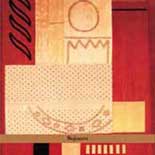 |
This is a lovely recording of music written and arranged by Marty Ehrlich (soprano saxophone, clarinet) for his Dark Woods Ensemble – Erik Friedlander (cello) and Mark Helias (bass) with special guest Marc Ribot (guitar). From the gorgeous head of The Open Return to the final beauty of The Modzitzer Nigun, there are nods in many directions. The orchestration is breathtaking, the music exquisitely rhythmic, propulsive, with many incantations of swing. Beautiful solos against fiercely intelligent backgrounds, structures building stories to surround heartfelt songs, lovely long unison lines breaking up into stars. Wonderful execution and collaborative interpretation of inspired, lyrical writing.
The Git Go sounds like the exuberant soundtrack for a black and white drive across town, the asphalt melting. Blind Willie McTell is a stunning and timeless duet, verse upon verse upon verse.
Beautifully recorded, highly recommended. |
 |
PHILLIP JOHNSTON recommends |
|
| SHELLEY HIRSCH'S O LITTLE TOWN OF EAST NEW YORK |
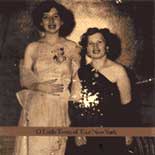 |
Shelley Hirsch is one of the most unique vocalist-composers to come out of the 1980s New York Downtown scene. Many people are described as unique, but Shelley is UNIQUE - sui generis, the ultimate her, the onliest. Her music is a combination of everything that's gone into her ears - classical music, jazz, kitsch, rock n roll, the mutterings of mad Subway Ladies, overheard cel phone conversations, poetry, word-jazz, the small print on cleaning products, Japanese advertising, family reunions, old movies on TV, love songs, art songs, songs for her father - all of it AT ONCE.
O Little Town Of East New York is perhaps the apotheosis of her art: part documentary, part confessional, part art music, part improvisation, part psychedelic dream trip through the nostalgia/regrets/fantasies/daydreams of childhood and teenage years in a unique now-already-ancient-history part of New York borough culture. Through an incredibly variegated career in both improvised music and contemporary composition in both the US and Europe, she has established a unique body of work, combining music with performance – everything she does is performance art. She expresses multiple personalities through characters inhabited and portrayed, often switching identities as rapid-fire costume changes, and instantly, flawlessly changing musical techniques and styles with them.
But all this would mean nothing, if it didn’t take the form of works like this incredibly moving evocation of her childhood in Brooklyn of the 50s and 60s. To give yourself over to this CD is to evoke the smells, the sounds, and the sights of a complex and byzantine inner life experienced by the young Shelley, tripping out on the inherent weirdness of everything around her in that multicultural working class world. She is like a young Jewish female Horse Badorties, just digging it all, but giving voice to it in a form that carries us into her inner world, transmuted by the insight of the grown-up Shelley looking back upon it all with compassion, tenderness and wonder.
Mention must be made here of the wonderful work of David Weinstein, who collaborated with her on the instrumental accompaniment: he is the perfect foil/enabler/accompanist/inspiration, running the machines (sampler/electronic programming), and playing all keyboard parts, like a one-man-orchestral-cabaret-piano-player.
If you don’t know Shelley’s work, let this sublimely accessible and entertaining work by your introduction into “The Far Out, Far In Worlds of Shelley Hirsch” – Hey, that’s another great Tzadik Shelley Hirsch record! |
 |
ARNOLD DREYBLATT recommends |
|
| ANDY STATMAN'S AVODAS HALEVI |
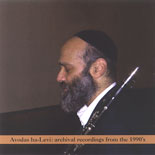 |
I have been friends with Andy Statman for over 30 years and I was deeply moved when his music found itself within John Zorn's "Radical Jewish Culture" rubrik. Andy is an uncategorizable musicians's musician, a man who has always followed his own musical and spiritual path without compromise yet with the utmost devotion.
Andy's early fame in the New York urban bluegrass scene in the early 70's set the tone for his later musical wanderings. Here he began "stretching" bluegrass to its outer limits by splitting open to jazz improvisation, even R&B and ethnic directions. Furthermore, Andy was one of the few of the early Klezmer performers who had actual experience with non-western modal musical styles, having played and studied with greek and middle eastern musicians in the new york area. By the time Andy began looking toward his Jewish roots in studying with the legendary Dave Tarras, he was amply prepared for the challenge. Dave eventually passed on his own clarinets to Statman, transfering his lineage to him. Yet even at this early stage in the Klezmer revival, Andy was not content performing in a purely nostalgic setting and he joined a Brooklyn religious community in which Jewish music was performed within a spiritual context, a world in which he has since raised a family and in which he commands great respect. But even this musical context was not to contain him, and Andy gradually sought his own musical home, in which all his musical influences and interests would somehow uniquely fit together, only because Andy Statman remained at its center. For years, he would take a car service from Brooklyn on Thursday nights for an endless jam with friends from all musical backgrounds in the basement of the Charles Street synagogue in the West Village, regardless of what else he was up to (alluded to in " Charles and West 4th"). It is the spirit of Andy's live sessions, surrounded by the musicians with whom he's played for years, which give these tracks their intimate and ecstatic character. Named after the writings of the Chasidic Rabbi Aharon HaLevi of Staroshelye, all of the elements of the Statman sound are present on these tracks: the soaring clarinet and virtuosic mandolin; tunes which often begin traditionally, and, in a seamless transitions and without warning propel the listener into unexpected worlds of improvisation. These tunes have their basis not only in Klezmer, but in Chasidic Niggunim, melodies from the Shabbos liturgy ("L’Cha Dodi"), and even Epiriis / Albanian tunes ("Lost Aisles of KDS"). This is a collection which shows off Andy's vision at its widest and most profound extremes, yet the music somehow always finds its way back home. Whether or not you've encountered Andy Statman before, this is THE CD for Tzadik and Radical Jewish Culture listeners to get to know this major figure in American Jewish music. |
 |
BILLY MARTIN recommends |
|
| TEIJI ITO'S KING UBU |
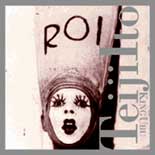 |
| At first, I was attracted to the dada-esque cover art. Then I pressed all the playback buttons on this (now obsolete) Tower Records listening station about 13 years ago. An overwhelming feeling of joy, liberation and self-affirmation came over me. This is Teiji Ito’s shamanic power at work. Every movement in this masterpiece score was (and still is) a surprise and revelation. This particular recording feels and sounds like an insiders’ take on the composer/performer at work in-the-moment. It’s like an anthropological field recording where each track relies not just on the compositional but the spirit of the performance. Sound-alchemist-shaman and cohort to Maya Deren (one of my favorite filmmakers!) is one of the great NY ‘underground’ artists that will always inspire and his King Ubu is timeless world-music. |
 |
OREN AMBARCHI recommends |
|
| OTOMO YOSHIHIDE'S CATHODE |
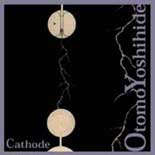 |
| Recorded in early 1999, Cathode is one of those important, groundbreaking releases that introduced the world to a new way of composition and improvisation. On this release Otomo radically redefined and reinvented his sound palette. Gone were the manic cut-up collages of his previous work and instead the listener was slowly drawn into a hypnotic, reductionist sound world where, for example, traditional Japanese acoustic instruments such as the Shô were beautifully juxtaposed with the sum and difference tones of Sachiko M's sine waves. This was one of the first major releases to prominently feature Sachiko M, an incredibly important and pivotal sound artist who was clearly a huge influence on the direction Otomo's music was taking. Cathode also introduced emerging younger artists from the thriving Tokyo "Offsite" scene such as Toshimaru Nakamura, Ami Yoshida and Uta Kawasaki, all of whom were to become incredibly important in the development of this music. As always, Otomo was paving the way and most people in-the-know cite this as a must-have release, a true cornerstone of electro-acoustic composition. |
 |
JENNIFER CHARLES recommends |
|
| JOHN ZORN'S DURAS: DUCHAMP |
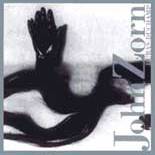 |
In Duras: Duchamp, John Zorn has created a record of sheer gorgeousness. Zorn’s two classical compositions are homages to two important French artists, the writer/filmmaker Marguerite Duras, (incidentally a longtime favorite of mine) and Iconoclast Marcel Duchamp, likely one of the Twentieth Centuries’s most influential modern artists. I believe creating an ekphrastic work is considerably more challenging than “covering” or interpreting someone’s work.
It is like some mysterious alchemical distilling, but perhaps it takes a fellow master to render it. Imagine a perfumer attempting to capture Guernica or Smiles On A Summer's Night, or any kind of untouchable work of art; but that is exactly what Zorn has done here, in these two very different and successful compositions. He has captured the essence of Duras and Duchamp.
The Duras piece is composed of four movements. His first movement opens with a beautiful ascending piano line played with grace and finesse by Anthony Coleman, and from there, Zorn slowly draws us into the sensual and dark world of Marguerite Duras. Violins are played by Mark Feldman and Cenova Cummins, long austere lines hover with plaintive melancholy, suspended over John Medeski’s Messiaenic organ beds. We also get warm percussion from Christine Bard and Jim Pugliese; from bird calls (again conjuring Messiaen) to haunting bells and gongs, and more primitive drum sounds. The entire four movements are infused with an ache, much like the ephemeral Romanticism one is filled with, when reading a Duras book. And like Duras, much is said with what is unsaid in a succinct space of time. Coleman’s playing, especially in some of the middle sections, captures some of Duras’ wistfulness, even bringing to mind “India Song.”
The second composition on the disc, 'Etant Donnes', is what Zorn calls “69 Paroxysms for Marcel Duchamp", a sound collage very much in the spirit of a Duchamp piece, which takes its title from Duchamp’s controversial last great master work ‘Etant Donnes', which Duchamp worked on in secret from 1946 to 1966. In 1969, 'Etant Donnes' was unveiled to the public at the Philadelphia Museum of Art, one year after Duchamp’s death.
Duchamp’s artwork, a 3-dimensional tableau, which at first glance is merely an old wooden door encased in a brick wall, on closer inspection, reveals an eye-level peephole exposing an intense, unusual scene- a woman’s partly visible naked torso, sex in the forefront, laying on a bed of leaves and branches, her left arm holding an old fashioned gas lamp, and behind her, a beautiful pastoral scene with a waterfall. Zorn’s composition evokes Duchamps’s abstract mental and surreal retinal world. One also can’t help imagining life as a series of spasms. Zorn’s piece of these 69 tiny convulsions include abstract sounds of nails being hammered, wood being sawed, bubbles, coughing, steps walking, door creaking, metal banging, bells ringing, wet sounds, of blending or slushing, and even the hiss of gas. Jim Pugliese plays the percussion on the piece, and his playing of more "conventional" instruments – bass drum, maracas, give the ear something other than what they are. Wonderful pizzing and glissing strings from Mark Feldman and Erik Friedlander lend the threads to the composition. Listening to Zorn's composition, it is easy to imagine Duchamp toiling away for years on his final great work. Zorn also conjures the spirit of Duchamp’s ‘ready-mades.’ As well as some of Duchamp's humor and provocation of surprise. If the ultimate paroxysm is an orgasm, the final response to eroticism, then I think Duchamp would wholly applaud Zorn’s composition. Duchamp once said eroticism was the only ‘ism’ he believed in. Also of note, one of the CD’s panels include part of Zorn’s handwritten composition notes for the piece, which I think both musician and non-musician could find fascinating, and an artwork in and of itself. |
 |
LUKAS LIGETI recommends |
|
| CHRISTOPHER ADLER'S EPILOGUE FOR A DARK DAY |
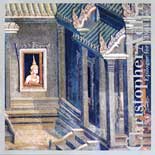 |
Ever since Claude Debussy became influenced by Gamelan music from Indonesia in the late 19th century, non-Western traditions have figured as a possible source of inspiration for occidental concert music composers. Yet it seems that surprisingly few composers have made use of the almost infinite range of possibilities the study of and interaction with such traditions affords in the areas of melody, harmony, rhythm, timbre, ensemble interplay, social significance and impact, and, even more generally, basic approaches to conceptualizing music and sound.
Christopher Adler is a rare example of a Western musician and composer who has immersed himself deeply in the music of a certain part of the world - in his case, Southeast Asia - with the objective not only of researching this culture and mastering its music tradition, but also in order to bring new ideas to Western-style composition. The pieces on "Epilogue for a Dark Day" are the result of Adler's intensive contact with the music of Thailand and Laos; performed by a mixture of Western and Southeast Asian instruments (Adler's instrument, the khaen, a mouth organ from northeast Thailand and northern Laos, figuring prominently), this is a new kind of music, not Asian, not European, not American, but somewhere in between, in a space of its own.
The lush, poly-tonal harmonic landscapes of overlapping chordal fields, the rhythmic evocations of Gamelan, the sounds of bells, gongs, but also of orchestral strings, and the superimposition of various melodic styles all make for a very unusual, inspiring listen and demonstrate that it is quite possible to come up with innovative and original music today, while not sacrificing visceral appeal. In many ways, "Pan-lom (Essays on Architecture 1)", the final and most expansive track, is the centerpiece of the album; it combines elements presented in the preceding pieces: melodies and ornaments for the khaen in "The wind blows inside"; clashes between harmonic worlds in "Three Lai", where Western orchestral strings join the mouth organ; shifting rhythmic accents for percussion ensemble in "Signals Intelligence"; and haunting, pensive harmonies, again from the khaen, in "Epilogue for a Dark Day". Each piece is a world of its own, but it is only taken together that, like pieces of a puzzle, they give an impression of the scope of Adler's imagination and the way he has integrated Thai and Laotian music into the occidental concert music canon by maintaining recognizable elements of both worlds and bringing them into harmony.
When intercultural collaborations, fusions, and cross-fertiliziations are successful, they demonstrate that humans across the globe have many more things uniting than dividing them. Yet it would be a trivialization and a lost opportunity to say that music is a universal language. Music is regional, but it is a collection of abstract languages, and as such, one type of music can combine with other musics to create something larger than the sum of its parts. Appreciating this takes a willingness for adventurous listening, but for those who are open to challenging their vision of the world through music, Christopher Adler can be the guide on a highly interesting and satisfying voyage. |
 |
CHRIS BROWN recommends |
|
| GORDON MUMMA'S LIVE-ELECTRONIC MUSIC |
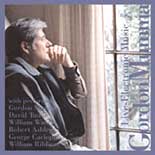 |
| Tzadik listeners should know that its catalog also contains some killer classics of live electronic music! Case in point, Gordon Mumma's disc by that very name: LIVE ELECTRONIC MUSIC. Together with the legendary David Tudor, who also plays the Argentine bandoneon on the track "Mesa" on this disc, Gordon literally invented a performance practice for live electronics in the late 1950s early 60's before modular analog synthesizers had ever been made. Gordon designed and soldered together his own circuits for generating and modifying sounds, creating some of the most hair-raising and sophisticated electronic noise that absolutely puts both today's digital software and analog circuit-bender musics to shame. "Hornpipe", also featured on this disk, was the first and still greatest piece of interactive music in which a musician interacts with an AI circuit -- what Gordon called "cybersonic" music. Stuffing bassoon reeds into the mouthpiece tubing of his French Horn, he moved around the performance space blowing spectrally complex squeals in each direction, while the analog computer strapped to his belt analyzed the resonances of the room. With each multiphonic, the calculators in the circuit got a fuller picture of the room's resonances, until a threshold was reached where complements of those resonances are fed back into the room electronically. The horn player then gradually "tames" the electronics by playing spectra that rebalance the feedback circuit and gradually turn it off. You had to be there to get the full drama of this piece whose form was created anew from the interaction of musician, circuit, and acoustic environment -- but the sound is on this disk in its full glory. "Medium Size Mograph" is another classic, a pun on the word "seismograph", as well as a great descriptor of the earth-shaking produced by a grand piano wrapped in a blanket to control the feedback of its own cybersonically modified sound projected by a large loudspeaker underneath its soundboard. All music that made history that every electronic musician should know, but sadly most have never heard. |
 |
GUY KLUCEVSEK recommends |
|
| PETER GARLAND'S THREE STRANGE ANGELS |
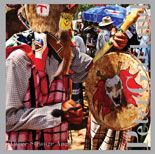 |
Peter Garland has composing his beautiful music since the early 1970’s, flying under the radar and fitting into no “ism.” Although sometimes associated with early minimalism, Peter’s music uses no systems and contains little repetition; nor does it apply classical music techniques to minimalist vocabulary. Although unabashedly tonal, neither does his music bear any resemblance to the “new tonality” of the 70s (Rochberg, Del Tredici).
Peter is also one of our foremost musicologists. But because he has done his research independently, outside of academia, he is not recognized nearly enough for his contributions, which include his seminal magazine, Soundings, published during the 70s and 80s, which contained both scores and writings on music of the Americas, and which introduced new generations to the music of Silvestre Revueltas, Dan Rhudyar, Conlon Nancarrow, and dozens of younger composers (at the time), such as Ingram Marshal, Michael Byron, David Mahler, John Zorn, Mary Jane Leach, and myself.
Peter spent much of his life living in the southwest and Mexico, and these influences can be clearly heard in much of the music on “Three Strange Angels,” which contains pieces written in the early and late 70s, and the late 80s, in its choice and use of instruments.
If there is a direct link to Peter’s music, it is Lou Harrison, who himself was much more influenced by the music of Asia and the Americans than by the European tradition. I feel this connection most strongly in Old Men of the Fiesta (1989-90), especially in dance 4a “abo,” played so beautifully here by Lynn Case, violin, and Rosalind Simpson, harp. The music is straight-forward, diatonic, extremely lyrical, and often uses rhythmic accompaniments to double the melody, like much of native American (and Lou Harrison’s) music.
Peter’s music can be primal and visceral: listen, e.g., to Three Songs of Mad Coyote (1973)--the first song is for 8 tom-toms (4 musicians), played completely in unison throughout and has the force and spirit of a Native-American drum circle; the second is for 2 bullroarers and 1 lion’s roar, and if you crank the volume, it can scare the bejesus out of you; the third is for 2 pairs of tom-toms, 2 bass drums, and 2 pianos which play only clusters created by a piece of wood which covers the entire white-key range of the keyboard. I feel I am experiencing percussion instruments in a completely new way in these pieces: I’m not listening to a composer trying to create interesting rhythms, I am literally feeling the full impact of the instruments themselves--e.g., like I’m hearing a bass drum for the first time. Peter allows time for the instruments to resonate, fill the acoustic space, demanding and creating their own sonic environment and time frame.
His music can also be drop-dead gorgeous. One of my favorite pieces of his, or anybody else’s, is Apple Blossoms (1972). Though written when Peter was 20 years old and a student at Cal Arts (as was I at the time), this is no student piece. It is scored for 3 or more marimbas, with low, rolled tremolos throughout, and is written by a composer with an ear already finely-tuned to the inner life of a sound, and psycho-acoustic phenomena like difference- and sub-tones (James Tenney was teaching acoustics as well as composition at Cal Arts at the time--he had a great impact on many of his students, including Peter and myself).
Peter can also be witty: his Obstacles of Sleep (1973), scored for a chorus of sirens, relentless pounding on metal, and horror-film piano sonorities, is a delightful, yet frightening sound portrait of a country boy’s experience in the city.
Peter has had performers who have championed his music over the decades, most notably pianist Aki Takahashi and Essential Music, but he deserves much greater recognition.Peter’s is a singular voice, and we can thank Tzadik for bringing it to wider attention. Please see also these Peter Garland releases on Tzadik: Love Songs and The Days Run Away. |
 |
MARC RIBOT recommends |
|
| PISSUK RACHAV'S ERETZ HAKODESH |
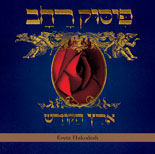 |
| I first heard the demo that would eventually become Pissuk Rachav's "Eretz Hakodesh" on my one (and probably only) trip to Israel in 2007 for some concerts of John Zorn’s Masada groups. The cathartic screaming, obscenity and obsessive blashemy that characterize Jeremy Fogel's lyric approach gave me the immediate sensation that Jeremy (who later, in personal conversation, revealed himself to be part of a surprisingly large community of Israeli Nietscheans) was deranged. But unlike many poet/ranters of our time, Jeremy’s derangement was somehow necessary. I might not have understood this if I hadn’t been listening to the demo in a traffic jam in Tel Aviv: Jeremy’s derangement is the best possible response. The one I’d been waiting for—plus it ROCKS. |
 |
SHANIR EZRA BLUMENKRANZ recommends |
|
| JOHN ZORN'S IAO |
 |
INVOCATION...in the beginning...doing away with all notions of what has been, and instead focusing on what can be...functioning much like a dream, complete with the fluctuating parameters of what is possible and what is not...most importantly, answering the questions of where, when, why, and how...the macrocosm floods the consciousness...SEX MAGICK...the arrival of humanity...instinct, flesh, bones, blood...an induction of the spirit...causing a change in an object of which that object is capable of by nature...the body which holds the central formula...SACRED RITES OF THE LEFT HAND PATH...negotiating the push and pull of set morality, and its inevitable consequences...the breaking of taboos and the adherence to forms of personal anarchy...THE CLAVICLE OF SOLOMON...the key used to prepare experiments of love, hate, dreams and invisibility...a legend of purification and sacrifice...containing conjurations to summon spirits and curses to constrain the dead, forcing them perform the operators will...LUCIFER RISING...the incantation...harmonized to the sway of possession...luring the subject into being...impossible to turn back now...LEVIATHAN...inhabiting in full...a documentation of an exorcism...destruction from the lowest point of the pentagram...fire, water, and chalice at the mouth of hell...MYSTERIES...exaltation with the wish of better things to come...thankful to be released from under the spell...a promise to celebrate life in all its incarnations...hoping the sun will rise and a new day will dawn...hallelujah...amen.
IAO challenges the idea of what music really is, reminding us of a time when sound was used for the most important reasons of the highest order |
 |
MATTHEW WELCH recommends |
|
| JOHN ZORN'S REDBIRD |
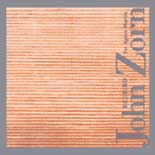 |
| This remains one of my favorite of all of the Composer Series. In the last fifteen years, the music world has seen the rise of what I'm calling “Feldmania” in which the hushed reticence of Morton Feldman's compositions have been ushered into the general musical consciousness with a long and loud crescendo. Being guilty of fetishing the quiet in music many times myself, I look back on the pieces of music that tickled this fancy, of which Zorn's Redbird continually found its way into my CD player. I listened to Redbird during times of intense contemplation and composition. Redbird is a very emotionally powerful experience despite it's economy and restraint of means, furthermore leaving space for the listener to exist inside or along side of the sonic landscape. There is just enough material to keep the musically addicted moving forward in time, and enough space to ignite one's imagination in the process. Music to dream to! A Must for the Feldman Fan Club. |
| ERNESTO MARTINEZ'S MUTACIONES |
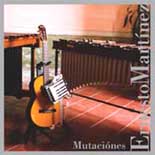 |
| This album continues to present one of the most satisfying kinetic and ecstatic experiences in recorded music. Ernesto Martínez's rigorous aesthetic and musical language that he coined “Micro-Ritmia” (on which Martínez elaborates upon in Arcana II) is an intensely complicated species of interlocking hocket techniques. I find Ernesto's style to be a remarkable combination of compositional fastidiousness and improvisational facility; often what is written and what is improvised within this method is hard to distinguish – an impressive achievement in any artistic medium! Martínez uses this technique throughout this album, but with a surprisingly unique focus and harmonic paradigm for each piece, encompassing a world that embraces traditional Mexican Son Style, Baroque (Pachelbel's Canon), Romantic chromaticism and chromatic Micro-polyphony (from Rimsky-Korsakov to Ligeti), and the complex polyrhythmic patterning found in Nancarrow to Reich. Martínez personal signature is so original though, no matter what the nascent nature of his subject materials are. His approach to instrumentation is very crucial to the voicing of his concept, preferring multiples of one color (multiple pianos, marimbas, guitar, etc – sometimes in combinations of multiples) with short or controllable sustains to aid the congealing of his multiple rhythmic lines and thrusting the material into the spotlight. His modification of the guitar with a mechanical keyboard interface is an incredibly resourceful invention, adding a (much welcomed!) whole new element of articulation and timbre to the guitar. This incredible recording is a must hear! |
 |
KEERIL MAKAN recommends |
|
| ALVIN CURRAN'S ANIMAL BEHAVIOR |
 |
Alvin Curran maintains a balance between humor and terror in his music in a truly masterful way. In his seminal work for sampler, “Animal Behavior” the voice of George Bush Sr. is turned into Elmer Fudd, hunting that wascally wabbit, Saddam Hussein. But it’s much stranger than that. There are choruses of wild animals, pinball machines, and other noisemakers. The piece transcends the banal limitations of the sampler by reveling in the banality of sampling. Because of Alvin’s incredible pacing and sonic imagination, what could be just slapstick humor becomes a menacing commentary on America, war, news, government, and technology itself.
About fifteen minutes into “Why Is This Night Different Than All Other Nights?” I think to myself, “I hate this, make it stop, I can’t take it.” There is an endless, slow, disjointed chorale of violin, accordion, and tuba, which keeps going, with awkward silences and unwholesome noises in the background. But I keep listening and then something happens—I’m suddenly lost in a wild, dark, jungle. I don’t know how I’ve gotten there, what I’m doing there, or how to get out. But it’s a miracle of sorts that Alvin could take me here without me realizing what he was doing. What happened to the chorale, my lifeline to time and space? It is truly a religious piece. Once the hated demarcation of time stops, we are left in a very weird, transcendent space.
If two spectacular pieces of music aren’t enough reason to buy this CD, here are a few more reasons. It is the first Tzadik CD! What better way to start a CD label that has become so important to such a heterogeneous group of musicians worldwide than Alvin’s indescribable music? Finally, Alvin writes the best program notes of any composer I know. But you have to buy the CD to read them. |
 |
J.G. THIRLWELL recommends |
|
| LA MAR ENFORTUNA'S CONVIVIENCIA |
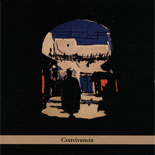 |
I first encountered Jennifer Charles' stunning velvety voice in 1995 at the dawn of Elysian Fields, her musical guise with Oren Bloedow. I have been captivated ever since. Jennifer and Oren began their La Mar Enfortuna project in 2001 to explore Sephardic and Ladina music and expanded it on the second album, Convivencia . Singing in five languages, Jennifer displays her greatest range and versatility yet, with her commanding the sultry, twisting melodies with nuance and ease.
Oren's arrangements show a deep love and rapport for the material, with solid support from the mighty Ted Reichman on accordion and Doug Wieselman on clarinets. The production is at once airy and intimate. One can detect the breath and the feel of the players in the room, if through a haze of incense and opium smoke. The clarinet valves clack gently and the strings squeak as you are deposited deeply into the moist womb of the players. These exotic, steamy and sometimes ecstatic melodies slither and coil, riding the slippery time signature grooves.
The opener, La Puerta Del Rio, is propelled by an irresistible shuffle; when Liaquet Khan's guest vocals enter, the music reaches a new level of transcendence. The traditional songs "Aman Minush" and "El Eliyahu" feature call and response between Jennifer's vocals and a male choir while hypnotic melodies punctuate the arid landscape. Oren takes lead vocals on "Persona Soy Yo, El Buen Sidi" with a plaintive delicacy. "Pali Mou Kanis To Vari" travels from a seductive beginning thru an electronic interlude, concluding with an almost punkish chant. Mixers Good and Evil are not scared to expand the sonic palette and add unexpected turns and dimensional spaces to the compositions.
Dedicated to the "peasants without land" who succeeded from Andalusia, this beautiful whirled music transports you to middle east from silken boudoirs to the souk and the desert caves. |
 |
MARTY EHRLICH recommends |
|
| FRANK LONDON'S NIGUNIM |
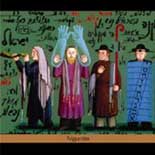 |
| Niggunim is a Tzadik recording I have often come back to for inspiration. Frank London, Lorin Shlamberg, and Uri Caine enter these “humming tunes”, with their roots in the Hasidic tradition, through many doors. At the center is Lorin’s voice, both cantor and congregation, artful while striving always to transcend that artfulness. Frank finds the soul in invention on these pieces, with trumpet counter lines that find rich beauties in small details. Uri supplies piano accompaniment full of varied moods, and then improvisational fantasias refracting the inner world these niggunim open up. More importantly, it is the combustion of these elements in the expressive realization of these songs that you hear. This is a richly collective recording, in the moment and through time. |
 |
EVAN PARKER recommends |
|
| JEREMIAH CYMERMAN'S IN MEMORY OF THE LABYRINTH SYSTEM |
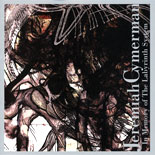 |
Although he considered calling the CD "Delirium in Lo-Fi", as a homage to Pierre Fantosme, JC finally chose "In Memory of the Labyrinth System". The track titles, from track 1 "Lateral Semicircular Canal" to the final track 10 "Ending of Nerve in Recessus Utriculi" are all named for anatomical structures in the inner ear. The labyrinth of the inner ear, with its implicit call to close listening is clearly part of the overall title's significance, but other, more Borgesian labyrinths are invoked too. What makes music musical for JC? - "a sense of magic, drama, tension release, dynamics and ultimately the ability to tell a story." Much listening has been required to create this music and it invites much listening from it's audience. JC speaks of having "placed two very strict limitations on (himself)" not using any other plug-ins than reverb, compression and EQ and not using any traditional clarinet voicing, "only nontraditional, mostly non-pitch based techniques.". Later in the process he decided to break these self-imposed limitations by introducing a small number of sound sources other than the clarinet. The music had arrived at a state of development where he had to "do what the music ask(ed) him to do". A great feeling.
Nevertheless this is clearly clarinet music. - but the options of time-shifting, over-dubbing, sample manipulation and obsessive re-evaluation result in music that often sounds electronic or computer generated. This is clarinet music - but made by a composer who also knows his way around the studio in general and Pro Tools in particular. This is clarinet music - but the way the voice of the instrument emerges and dissolves into the totality and the way in which the studio skills merge seamlessly with the instrumental skills make for a very intricate hybrid and a delightful listening experience. I was at times reminded of the work of Richard Maxfield who, ineterestingly, began as a clarinetist and later in his short life moved over to analogue studio based "electronic music". In the intervening forty or fifty years the shift from the analogue to the digital realm has made sound manipulation procedures that would have taken months achievable in hours or seconds now. The equivalent of the final track, "Ending of a Nerve..", with it's 10,000 layers and micro samples would almost certainly not be possible in a lifetime's work in the analogue domain. The journey through the ten tracks arrives at a very abstract place but even here the clarinet is at the core of the music.
An astonishing achievement already, but I have the feeling that Jeremiah Cymerman will continue his researches and will continue to astonish us. |
 |
JIM O’ROURKE recommends |
|
| ARNOLD DREYBLATT'S ANIMAL MAGNETISM |
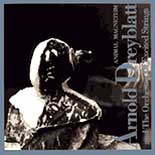 |
| A lot is made of the cross over of minimalism and rock and roll. The Power and the Glory, if you will. As much as I like the music made by his generation, no one has made me shake my fist and bang my head as the music of Arnold Dreyblatt. It may be my years in marching band, but "Animal Magnetism" for me stands as the pinnacle of upper echelon harmonic nirvana meeting the toe-curling, foot stomping, pure-adrenalin rush of the banging drum. I have introduced this record to countless friends, all from different musical tastes, and i always see the same reaction: wide-eyed awe at the power, glory, beauty and sheer transendance of Arnold Dreyblatt and his "Animal Magnetism" |
 |
GYAN RILEY recommends |
|
| SECRET CHIEFS 3'S XAPHAN |
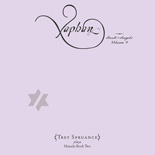 |
| As an avid Secret Chiefs fan and part-time collaborator with members Timb Harris and Ches Smith, I assumed I was going to like Xaphan. What I didn't know is that it would become one of the few records that I listen to over and over again. The boundless variety of timbre and texture in Trey Spruance's arrangements of these infectious tunes is just awesome. The band pulls off beautifully haunting, sensuous snaky melodies and pounding grooves alike, the orchestrations constantly evolving into a different animal with each new section. But most importantly, it's just got that inexplicable magic that beckons me to throw it back in the disc player time and time again |
 |
TREVOR DUNN recommends |
|
| ANTHONY PATERAS' MUTANT THEATRE |
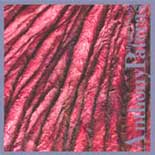 |
| This release covers a lot of ground and continues to fascinate with each listen. Selections include a percussion sextet, a solo piano homage to Nancarrow, and an amplified quintet of contrabass recorder, laptop, percussion, viola, and trombone. Composition and performance techniques run the gamut from graphic scores and realtime sampling to multi temporality and orchestration evoking psychoacoustic phenomena. My favorite piece on this disc is "Twitch" the aforementioned quintet. Written specifically for colleagues (as is most of the record) and their idiosyncrasies and instrumental modifications, it is a must-have for any listener with ADD, which at this point in time probably qualifies all of us. Pateras is a great example of a 21st-century composer drawing on roots from the previous era while creating his own language that relates to the world now. And, while serious and methodical, his pieces are created with an open mind and a sense of humor. How can one argue with a disc that includes a "decrepit violin", "domino/balloon prepared mousetrap", the smashing of lightbulbs and "extreme klangfarben concrete? Highly recommended. |
 |
CHUCK BETTIS recommends |
|
| ADACHI TOMOMI ROYAL CHORUS' YO |
 |
| Truly expanding upon a language is difficult, but Adachi Tomomi''s Royal Chorus presents us with complex vocal music without the stale stench of academia overpowering his compositions. Fun and inventive; very few have successfully braved the path of all vocal ensembles while simultaneously expanding the language with the use of both vocalese and native tongue. "Yo" starts off with the ferocity of Hardcore Punk and transcends a path carved by Meredith Monk, always grasping at your ear along the way. One of my top 10 recordings for vocal inspirations. |
 |
HEUNG-HEUNG CHIN recommends |
|
| DAVID SLUSSER'S DELIGHT AT THE END OF THE TUNNEL |
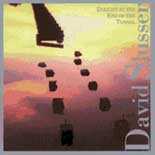 |
David Slusser always seemed like Hollywood's secret, but we all should know about him. He is a master craftsman and saxophonist composer, working in the film/animation industry composing and creating sound design. "Delight at the End of the Tunnel", released in 1997 still remains as colorful, eclectic and refreshing as when I first listened to it. I'm reminded of today's Kenny Wollesen (Wollesonics) with Slusser's half ethereal/futuristic notes proving that Slusser's music doesn't sound immediately dated like certain period pieces.
I wanted to go places even though I was sitting in my room. His soundscapes/poems/collages/compositions take me there as if I'm sitting in a time traveling machine: an electronic Pong-like field, the aura of birth, a dragon, industrial zone, the sly and sexy brass of film noir, fear, animation memories, haunting computerized dementia as if awakening from a nightmare, current events on tv, international voyage, to distorted documentary-like voices and more. I'm never in one place and I'm picking up clues on how to evoke mood and ambience for moving images. He explains what methods are involved in his creations--—very useful information for all. His approach runs the gamut from using instruments (such as layered piano construction/deconstruction, accordion), voice, effects, ambience to spontaneous studio assembly and more. What's interesting is his question back then--—is this music or more of a collection of well collaged sound that serves a function for the visual realm—--hence the different ways of creating his pieces.
Today, I forget that he's asked that question because it's already music to me and I've been having fun listening and learning. Then, once you know how he operates, watching him perform in a context like John Zorn's Cobra or contributing to Zorn's Satyr's Play is like holding a box of Slusser secrets. Only you don't want to keep it a secret and you tell everybody about him. |
 |
MARK DRESSER recommends |
|
| NED ROTHENBERG'S QUINTET FOR CLARINET AND STRINGS |
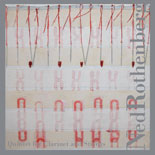 |
| Ned Rothenberg’s Quintet for Clarinet and Strings is a rich CD whose enjoyment increases with repeated listening. Beautifully performed by the Mivos Quartet and virtuoso woodwind player Rothenberg. It has elements from different musical influences but is by no means eclectic. There are indeed formal structures in most of the pieces, however the overriding impression is a wonderful playfulness between clarinet and strings. One of the outstanding aspects of this CD is the integration of the personal language of extended techniques that are signature of Rothenberg’s solo playing including circular breathing, multiphonics, and odd meter cyclical grooves. Yet the music is driven by rich melodies, evocative harmony, and contrapuntal inventiveness. He juxtaposes tempered and non-tempered pitch in a lyric way and the characteristic rhythmic drive that is found in all of Rothenberg’s music is deftly orchestrated for strings. The music has an ease to it that would suggest that these compositions would become an often performed and welcomed addition to the rich repertoire for clarinet and strings. The challenge will be to find a clarinet interpreter of Rothenberg’s skills. The revelation of this CD is its unstuffy and rewarding totality. Highly recommended. |
 |
TIM SPARKS recommends |
|
| URI CAINE'S MOLOCH |
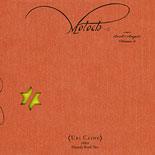 |
| One of my favorite recordings of John Zorn's music is Moloch, Book of Angels 6, which features Uri Caine on solo piano. I like when solo piano becomes a transparent, concise expression of a composer's musical vocabulary. The piano music of Mingus, who wrote for a legendary ensemble or Shostakovich, who was a great orchestrator, come to mind. I also find this quality in Uri Caine's solo renditions of John Zorn's songbook on Moloch. Like Bud Powell's brilliant Verve recordings embodying the language and spirit of Bebop, Uri Caine employs killer chops to evoke the passion and complexity of a Masada set. He also has an intuitive feeling for the subtleties of melodic and harmonic gravity implicit in the Jewish scales that Zorn uses as a foundation for his Masada and Book of Angels compositions. From the high energy Rimmon to the bittersweet ballad Nuriel, Uri's sensibility and commanding technique make Moloch one of my favorite discs in the Tzadik catalog. |
 |
IKUE MORI recommends |
|
| NI HAO'S GORGEOUS |
 |
| Japan has a long standing tradition of the all girl band—Papaya Paranoia, Shonen Knife, TohBahnDjan, Saboten, Afrirampo, and many many more. In 2000 these 3 girls got together and created NI Hao. Gorgeous was their first full length CD, and it was released in 2006 after they had toured and worked together for 6 years. Simple bass and drum lines groove with vocals that sound like the title song for a 21st century anime TV show, but with a bizarre twist. I had the opportunity to see the band live and was very impressed by their show. Their playing was tight and fast, and the interweaving of the bass, drums and vocal lines was flawless, complex and loopy. Ni Hao is a unique and powerful band, and this first album of theirs is one of my very favorites cds on Tzadik. Very enjoyable. |
 |
GREG COHEN recommends |
|
| MASADA LIVE AT MIDDLEHEIM |
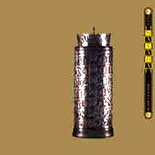 |
| The CD I have recently re-visited and was pleasantly surprised by is "Masada Live in Middleheim". Playing in Masada has been the most important musical experience of my life and this performance seems to catch the spirit of what the music making is all about on the road. That factored in with the great concert sound that the Belgian radio captured on this recording makes it one of my favorites. Maybe a few orange pancakes may have something to do with it as well? |
 |
HENRY KAISER recommends |
|
| DEREK BAILEY'S BALLADS |
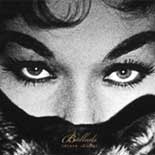 |
There are so many things I could have to say about this great performance/recording. I'll just dash off eleven of them.
1. This recording can function as a Rosetta Stone for the jazz listener who does not naturally grok Derek's approach to music and improvisation.
2. Derek goes for both his best post Jim Hall jazz tone and his own personal timbre vocabulary here. This is the only place to hear those two things in one place; all intertwined.
3. A lot of care was taken in the recording process here. Both great recording technique and time and space given to say what he wanted to say.
4. Perhaps this is one of the most musically preconceived, particulary in intent, of all of Derek's solo recordings. And thus, stands in stark contrast to them.
5. It's a concept album.
6. There are other solo recordings of Derek's where he enters into the standards area - but he refrains from stating the theme in any particularly decipherable manner for most listeners.
7. Like his great acoustic solo album, AIDA on the Incus label, Derek's playing is more reflective here; almost a kind of meditation.
8. Derek finally had an acoustic guitar the was up to the level of his dreams here. I can hear his love for this specific instrument in the music.
9. Besides Derek's expansion of harmony and melody on the traditional standards here, one can hear amazing transitions of rhythm from ballad-space to Bailey-space. Try concentrating on that as you listen.
10. I feel extremely grateful to Zorn/Tzadik for affording the unique opportunity for Derek to make this album. Domo Arigato Gozaimashita!
11. Listening to the album again as I type this, it's interesting for me to invert the expected perceptual order. Instead of listening to Derek play a traditional ballad, then flying off into his personal music, try listening to the personal music turning into ballads. For me, who listened to and loved Derek before I listened to jazz, the ballad structures are what is weird and the Bailey-style playing is what is normal. |
 |
JEWLIA EISENBERG recommends |
|
| MEREDITH MONK'S BEGINNINGS |
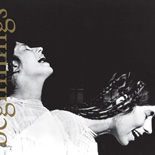 |
| Anyone working seriously with sound and the body is in debt to Meredith Monk. Her music is both primal and ambitious, exploring the technical and the spiritual range of the voice. She is justly famous for her multi-disciplinary work, but Beginnings presents a more focussed picture, using archival recordings over the course of decades to look at the evolving vocal work of an American master. This album is an intimate treasure. |
 |
FRANK LONDON recommends |
|
| THE MYSTIC FUGU ORCHESTRA'S ZOHAR |
 |
| Given the enormity of the Tzadik catalogue, it's difficult to pick out one title, but the Mystic Fugu Orchestra's Zohar has dwelled in my subconscious, just below the surface, since I heard its first scratches. Capturing the ethos of the of pre-modernity in an aural daguerrotype, Zohar places you into the early Russian ethnomusicological expeditions. Beregovski and An-ski seeking out the last remnants of premodern Yiddishkayt. Eye and Zorn are phenomenal. As a living tribute to fetishists of the 'authentic' Zohar stands alone. |
 |
ROB BURGER recommends |
|
| TIM SPARKS' TANZ |
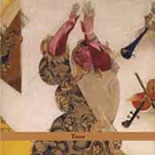 |
| Tim Sparks is one of the greatest and most overlooked living guitarists of our time. I became introduced to Spark's work when Kazunori over at Tzadik sent me a copy of "Masada Guitars," a recording of interpretations of John Zorn's Masada works, featuring solo performances by Bill Frisell, Marc Ribot and the venerable Sparks. This listening experience led me to some of Spark's other CD's on Tzadik including "Tanz," a beautifully intimate and harmonically rich recording made for the Radical Jewish Culture Series, featuring top shelf ensemble playing and virtuosic musicianship of Sparks, along with the tasteful accentuation and rock-solid rhythm section work of bassist extraordinaire Greg Cohen and master percussionist Cyro Baptista. Highly recommended! |
 |
JEREMIAH CYMERMAN recommends |
|
| ANTHONY COLEMAN'S SELFHATERS |
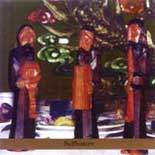 |
If the concept of the self-hating Jew developed from a merger of the image of the "mad Jew" and the "self-critical Jew" then I cannot think of a more perfect candidate to represent this idea in music than Anthony Coleman. I first encountered his masterpiece “Selfhaters” when I was twenty years old and suffering from a mild-to-extreme identity crisis. Ten years later the crisis is at least partially resolved but “Selfhaters” continues to confound me.
In “Jewish Self-Hatred: Anti-Semitism and the Hidden Language of the Jews” Sander Gilman defines Jewish self-hatred as: "...the internalization of the negative stereotypes about who you are--the identification with the reference group's image of you as "the other" in society.” Embracing the role of “the other” the music on Selfhaters deals largely with the “hidden language of the Jews” (in this case musical but more specifically klezmer) and from beginning to end “Selfhaters” takes that language and puts it under a fluorescent light, exposing the flaws and accentuating the imperfections. The laughing clarinet becomes the tired, sighing misery stick. The upbeat 5/4 rhythms present themselves as manic and compulsive, driving the music closer to neuroticism than swing. Anthony’s haunting vocals sound as if a withered and dying Kantor is trying one last “Avinu Malkeinu” before he drifts off into the night. Taking idiomatic terminology from the klezmer language and dissecting it, Anthony masterfully “reduces the language to a single pathetic cry”. The effect is chilling. The music feels lonely and terrifying and continues to inform and influence a great deal of my own music and aesthetic.
To me “Selfhaters” is a benchmark album against which I measure all others in the Radical Jewish Culture series. With this release Anthony looks at as personal a subject as possible and deals with it with an eloquent and singular musical vision while simultaneously pushing it to the absolute edge. And in case you’re wondering, NO, the meat of this dish is not just in the concept. “Selfhaters” strikes a perfect balance between conceptualism and visceral, if not surreal, energy. Composition and improvisation work perfectly together and it’s all performed by a masterful band who possess an intimate knowledge of the composer’s methods. In short, it just works.
Anthony continues to be one of Downtown’s most fascinating characters and “Selfhaters” is his undisputed masterpiece, a thrilling and bizarre listening experience that still has me scratching my head ten years later. |
 |
DAVE DOUGLAS recommends |
|
| WADADA LEO SMITH'S KABELL YEARS |
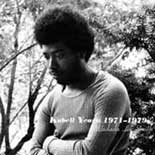 |
Those who have heard trumpeter and composer Wadada Leo Smith recently--at the pinnacle of his powers--may not be aware of the seminal work he documented for his own label in the early to mid-seventies. The 'Kabell Years' is akin to a Mosaic box set in breadth, importance and sheer brilliance of artistic vision. The four discs here foreshadow so much of the music that has happened since that time. From solo pieces on various instruments to quintets with Oliver Lake, Anthony Davis, Wes Brown, and Pheeroan AkLaff, Smith laid out a template for creative ensemble composition and improvisation that continues to shine a light for aspiring music makers. This set is also a snapshot of creative New Haven at a time when so many key players were on the scene there. Numerous musical scores and musicians' testimonials are included in the notes--it's a true collector's (and listener's!) item.
Beyond trends, movements, or categories, Wadada's music inhabits its own galaxy. In all these pieces you will find both experimentation and excitement--a summation of everything Smith had done up to that time and a prophetic vision of what has followed. |
 |
JON MADOF recommends |
|
| ZAKARYA'S SOMETHING OBVIOUS |
 |
| The first thing that struck me about Zakarya's 'Something Obvious' was the interplay between Yves Weyh's accordion and Alexandre Wimmer's guitar. The sound was at once old and new, traditional and radical, in short everything I love about Tzadik and Radical Jewish Culture. In the hands of less capable and genuine musicians, this combination could be mined for the type of kitsch that infects some of what passes for 'Jewish Music.' But Zakarya, including the wonderful rhythm section of bassist Vincent Posty and drummer Pascal Gully, uses it to create something altogether new, seamlessly weaving together the strands of history and tradition into an album of beautiful, powerful and vital music. |
 |
ERIK FRIEDLANDER recommends |
|
| MEPHISTA'S ENTOMOLOGICAL REFLECTIONS |
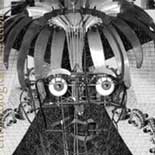 |
| Put three strong composer/players together in a band and chances are there will be moments of greatness. But it’s rare when the musicians’ efforts result in, not only moments of greatness, but a sustained original sound - a band! Sylvie Courvoisier (pno), Susie Ibarra (perc.), and Ikue Mori (laptop), manage this difficult metamorphosis with style and ease. Entomological Reflections bubbles over with invention--my ears can’t get enough of the sonic landscape this super trio of savvy improvisers creates. At times bent, broken, and tough-minded, other times plush and luxurious, the ground they can cover is surprising, modern and always natural. They manage to be full-throated, pedal-to-the-metal players without stomping on each other’s contributions, and because of this intelligent give-and-take there is a a clear-eyed fluidity in the music. It’s the right players, at the right time--a happenstance. We are lucky to have it so beautifully documented. (personal favorites: Void, Beloukia, Shifting Roll) |
 |
RAZ MESINAI recommends |
|
| MARYANNE AMACHER'S SOUND CHARACTERS |
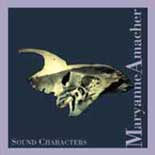 |
Without a doubt one of the most innovative and influential sound alchemists of our time. Her profound ability to give shape to even the most microscopic of frequencies is both terrifying and masterful.
It's easy to argue how a CD could represent an artist like this, whose demand for sonic perfection and clarity challenged the ears and minds of even the bravest of sound engineers. But these recordings are important portable documents that infect not only the listener but the stereo systems they are played through as well. Just as our bodies host an abundance of micro organisms, her music contains frequencies within frequencies, secrets within secrets, and it is her ability to hear it, feel it, and project it through the dead bodies of loud speakers, breathing life through their circuitry, that makes her a treasure to contemporary music |
 |
LARRY OCHS recommends |
|
| FRED FRITH'S CLEARING |
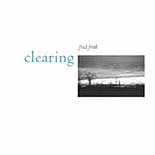 |
| If there's one person in Tzadik's catalog not named Zorn who doesn't need a plug, it's Mr. Frith. But because there are so many great CDs of his out there, let me encourage you to choose "Clearing." It's just one of the most poignant 'solo guitar' recordings on the planet; one I listen to on my iPod over and over. And I place 'solo guitar' in quotes because as always there are many things being applied to the guitar besides finger-tips and picks leading to an at-times orchestral celebration of unique sounds. |
| CHRIS BROWN'S LAVA |
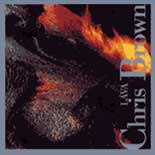 |
| When this CD first came out, I tried to do my first listen while driving on a busy freeway-under-construction here in California. The rhythmic complexities of the music literally unbalanced my physical coordination and I had to pull over before I went off the road. When listening in my studio, it's just one of the most fascinating pieces of electro-acoustic music out there, and still today seems like a groundbreaking work that would be worth your time and attention, your complete attention. |
 |
HAL WILLNER recommends |
|
| DION MCGREGOR DREAMS AGAIN |
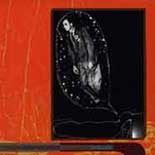 |
| Dion McGregor Dreams Again is unquestionably an experience, and a must-have recording. McGregor was what is called a somnamloquist, a voluble dreamer – and basically he dreamt OUT LOUD. No bullshit. McGregor’s “sleeptalk” was taped by his roommate in the early sixties during the nocturnal hours and some of these dream rants were released as an album that quickly disappeared. This is its uncensored sequel. It doesn’t work as background, and forces you to listen – but to allow yourself to enter McGregor’s world and be there with him seeing and experiencing what he does (and his reactions) - every emotion will hit you – terror, hysterics, sadness, love, hate. Heartbreaking and lustful, it is raw and there is no funnel of what comes out of his subconscious… Believe me, Lord Buckley would have sold his mother to be able to do this stuff… just listen…. Then check out ”Where is the Wonder” – a song he wrote that Barbara Streisand recorded a year after most of these tapes were made…… “When the Sky of Blue Turned Wild” indeed!!! |
 |
LISA BIELAWA recommends |
|
| CHIEN-YIN CHEN'S PURR |
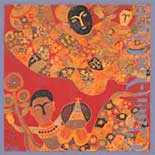 |
| Although one might be inclined to hear Chien-Yin Chen's music from the point of view of her cultural background (grew up on a farm in Taiwan, studied in Vienna, then moved to New York City and became immersed in the noise-based, alternative music scene), I find that what comes through in these five acoustic chamber pieces is her own unique blend of boisterousness and sweetness. The disc begins with "Cloud Walking," for a motley assortment of extremely distinctive instruments - pipa, trumpet, piccolo, piano, percussion - that enter like a mad cartoon race and keep us feeling throughout like we are in a small kitchen with a loud (but loving) family. The second track, "Chen Dah at Large," also gives us this combination of spikiness with soul, ending in rapturously gorgeous piano chords that gather unexpectedly and take center stage. One gets to hear the composer herself on the organ, in the title duet "Purr" with the sublime Mark Dresser on Double Bass. This track and the next one, for three guitars, show Chen's gift for entering deeply into the distinctive personality of the solo instrument and the richness of its idiom. The last piece on the CD, "Fuse Box," is the earliest, and also the first piece known to this listener. It is a rewarding journey to consider these pieces as the New York evolution of a truly gifted communicator. This CD is excellent company - sophisticated, fun and deeply personal. |
 |
ALVIN CURRAN recommends |
|
| ANNIE GOSFIELD'S LOST SIGNALS AND DRIFTING SATELLITES |
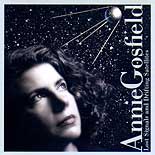 |
| The fierce foot-pedaled thuds, k’boomin-womps, cracks ‘n clangs, the multi-pulsing industrial jitters, the anvil hammered attacks and gorgeous free range noise and speed that we associate with Annie’s music is for a moment under wraps; out comes Tchaikovsky’s brother playing a Jon Rose violin in the remote interstices of our planet’s endless galaxies. This simple but brilliant stratagem places us in a most familiar but unlocalizeable space - somewhere like floating in a dream in the comfort-zone of a classical violin concerto accompanied by an invisible outer-space orchestra – playing, unintentionally in the Cageian imagination of Atlas Eclipticalis – the blips, beeps and other random galactic-sounding detritus that has attracted so many of us since the invention of the short wave radio. Now with outer-space made audible by astronomical slight of hand: transposing its signals into the human hearing range. Is the violinist the last surviving dazed musician, wandering on earth after some unnameable disaster, or is this genuine made-up environment simply Annie’s natural love of sounding-space, and particularly spaces that generate their own musics day in day out : (factories, large computer rooms, clubs, streets, weather, landscapes and beyond). Here it’s pure beyond beyond since the violin, so packed with the human story (at least 7-8 thousand years worth) is really our own front door to a house opening on infinity. Whatever the violin does, nodding toward post-central Europe or toward unplayable harmonics and pure bow grit, noise or gypsy hunger pains or liberated contours, it all sounds marvelously plausible, simply right, as if the music of the future might have already begun in a concert hall without any known address. Thanks Annie. |
 |
NED ROTHENBERG recommends |
|
| MARK FELDMAN'S MUSIC FOR VIOLIN ALONE |
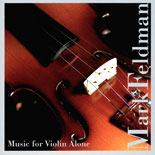 |
In the last part of the 20th century virtuosity began to acquire a bad name. From Post-Cageian attempts to remove personal intention from the compositional process to the vacuous wanking of various guitar 'heroes', listeners were tired of musicians hiding behind technical bravado; flashy licks seemed to be standing in the way of musical substance. We want to hear the heart, the humanity of the player, not what he has been practicing. With Music for Violin Alone Mark Feldman shows that technical command acquired in the course of sincere personal and musical investigation trumps all other concerns and widens the ears and heart of the fortunate witness.
Feldman knows the violin SO intimately, his playing shows the deepest love for his instrument. He knows where his own compositional identity lies within the wealth of his material. He uses his discoveries not for demonstration but, so much more interestingly, to tell stories. All the pieces in this collection have strong narrative flow and attention to overarching form. Feldman introduces materials in ways that seem both surprising and, at the same time, inevitable.
The solos are brimming with personality, and thus we find the music really lies outside idiomatic categories. One can hear the wealth of Mark's experience - he is funny, passionate, angry, biting, romantic, capricious. This is communicated via his personal sonic language which includes incredible glistening harmonics, hollow flautandos, grating scrapes made musical by their strong directionality, unabashed jazz licks, beautiful cross-bowed chords played with perfect intonation. The titles are accurate and thoughtful: Elegy shows the deep hurt of a man who has known loss, Stalker perfectly controls chaos and sets it against a mysterious lurking presence. Fantasy for the Violin brings forth such sonic pathos that it seems as if the instrument might burst from exertion. Calista evokes a touching vulnerability, which is a perfect offset to the seemingly effortless mastery with which all these works are played. For one becomes aware that in fact great effort is being made, but not effort in execution, effort in expression!
If you have the time and mindful focus to enter the personal world of an unapologetically virtuosic instrumentalist, Mark Feldman's Music for Violin Alone, (along with his work with pianist Sylvie Courvoisier) will make your musical world a larger and more verdant place. |
 |
PAOLA PRESTINI recommends |
|
| LISA BIELAWA'S A HANDFUL OF WORLD |
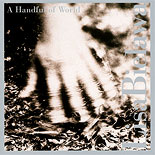 |
| I have had the pleasure of knowing Lisa for a while now, and it is always a joy to enter someone's musical world: you get to know them better in an intimate way that is only possible when words are not in the way! This CD is a must have: if you do not know Lisa's voice, then this vocal album is the way in: she explores the confines of possibility when simultaneously playing the violin and singing with Carla's wondrous work on Kafka Songs, and, her own beautiful vocal tone is heightened by the labyrinthine world she creates through her use of multi-tracking and electronics in A Collective Cleansing. In Kafka Songs Lisa's elegant masterful language takes full advantage of Carla's talent--Carla's skill and tone is outstanding! In a Collective Cleansing, the intertwining voices are stunning and the use of electronics is innovative; mid way through the electronics surprisingly sustain a vocal chord lushly and the work evolves into a world of dark, supremely lovely melodies supported by wonderfully inventive harmonies. A trip worth taking. |
 |
ANNIE GOSFIELD recommends |
|
| HA-YANG KIM'S AMA |
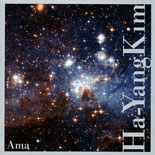 |
| Ha-Yang Kim's work incorporates everything from the traditional cello canon to her own highly developed vocabulary of extended techniques, combining acoustic and electronic sounds, Western and Eastern influences, and notated and improvised structures. Ha-Yang utilizes these diverse approaches in a music that is purely hers - the sum of the parts is cohesive, organic, and extremely personal. Her cello harmonics sound like no one else's: they skirt the abrasive, but embrace beauty. Her sound world alternates between pure cello tones and electronically altered sounds, bringing noise into the mix with subtlety and elegance. "Lens" is a gorgeous example of a composer/performer putting all they have on the table in a solo work that is emotional, meditative, and revealing. "Samtak" and "Oon" are performed by her duo "Odd Appetite" with percussionist Nathan Davis, and demonstrate the telepathy of two well-matched musicians who can follow each other's steps seamlessly. "Metasmatter", composed for a sextet of great New York musicians including Clare Chase (flute), Jennifer Choi (violin), Joshua Rubin (bass clarinet), Ha-Yang Kim (cello), Eric Huebner (piano), and Nathan Davis (percussion) shows a more urgent, rhythmic, riff-based approach. Ha-Yang's refined sense of contrast and tension is what sets her music apart. She finds a beauty that veers between delicacy and strength hidden in these unconventional sounds. |
| JOHN ZORN'S BOOK OF HEADS |
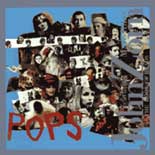 |
| "The Book of Heads" is a remarkable example of idiosyncratic writing for the electric guitar, and an encyclopedic collection of incredibly far-reaching extended techniques for the instrument. Written for Eugene Chadbourne in 1978, It is fearless, funny, beautifully crafted, and always surprising. I can think of no other piece, or collection of pieces, that makes such great use a specific performer's skills, personality, and unique virtuosity. Eugene's dirty fingerprints, are all over it, not only in his twisted take on all kinds of American vernacular music, but in his use of balloons, talking dolls, and truly odd techniques. This performance by Marc Ribot, recorded 20 years after the piece was composed, adds Marc's own dazzling technique and his commitment to the darker side of the guitar. Comprised of 35 etudes Meticulously scored in Zorn's unique style,"The Book of Heads" defines the modern vocabulary for the instrument, and should be required alongside Fernando Sor for any guitarist wanting to flex their fingers and stretch their mind. This brilliant collection of miniatures is perfect in its attention to detail, noisy provocation, and pure self-expression. |
 |
EYVIND KANG recommends |
|
| JOSE MACEDA'S UGNAYAN |
 |
| I listen to this music on headphones while traveling. The point of departure, with its bamboo stochastic, periodicity of low horn, the high whistle, recurring around the heart of the vocal chorus- is of SE Asia, but like a google map which just keeps expanding, it soon includes the whole world. The individual sound is no longer heard-it quickly turns to water, a hard rain becoming a flood, giving one the sense of ecosystem within ecosystem. In fact the very scale of the piece goes from the physical to the ethical level. The scale of the instrumentation and sound distrubution-one might call it "national"- is a mixture between the pure and impure. Pure because the interlinking is accomplished in a purifying act, that of ritual, of art; impure because the medium of national radio requires a certain collaboration with an amoral regime. |
 |
JEREMY FOGEL recommends |
|
| BROWN WING OVERDRIVE'S ESP ORGANISM |
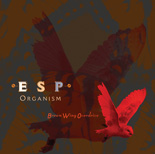 |
| This world has exploded into something else - lives are lived predominantly on an endless network of man made computing machines - thoughts follow each other at breathtaking speeds - it feels hectic even in your little room - the molochs of power are abstract & using space age technology to enslave every single child - our ice caps are melting & Japanese scientist say we need to get the hell out of this planet right now - feels like the future is invading us & not the other way round - through it all, of course, the human quest to communicate with the world of spirit - shamanism - remains - Brown Wing Overdrive are a musical triangle of explorers plunged in the depths of a sceance with an age no one even knows how to name - ESP Organism draws hauntingly manic attention spans through carefully elaborated free flowing hysteria & engages with a fearless lust for everything - let's face it - we've murdered the tribes & find serious difficulty at reaching transcendence on facebook - to the robots they're building for us to have sex with it won't matter if you play Serge Gainsbourg or Mao Tse Tung - you can't go back - onwards we must - the Avant Garde used to be ferociously skilled soldiers plotting a course for the army to follow - this music plots the path of the soul in a reality of electronic & digital meltdowns - Grand Master Jodorowsky calls his poetry the enlightened shit of a toad that swallowed a firefly - How do you translate that into algorithms? - ESP Organism? - This album goes behind enemy lines to advance the only real cause - the widening of the area of consciousness - its armed with a systematic form of manic delirium - if you're reading this, you might be interested in the idea of a lunatic fringe - if you are, you are interested in this music - check it out & if you want to have your ESP Organism, consider purchasing it - Not because of the increasing risk the illuminati of capitalism will seek you out & fuck you up - because we need to support the ability to dare being completely different, to dare being completely insane, to dare being free. |
 |
JESSE HARRIS recommends |
|
| JIM O'ROURKE'S TERMINAL PHARMACY |
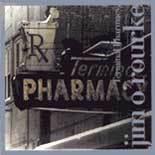 |
| If dreams had sound, it might resemble Jim O'Rourke's album Terminal Pharmacy. Long periods of silence evolve into a low hum, a swirl or harmonic whistle, interjected suddenly with an event, perhaps music of a past time, a noise in the street, a wind machine, or someone jangling change in his pocket just above your head. It's as if you don't know whether you're asleep or awake, or whether you dreamed. A beep sounds, like an alarm to wake you up, but you seem to sleep on. It stops. More silence... Despite that the music is stark, abysmal and even terrifying at times, yet there is something soothing and hallucinatory that calms and compels the listener to listen through in its entirety, as if hypnotized. |
 |
STEVEN BERNSTEIN recommends |
|
| DAVID TAYLOR'S RED SEA |
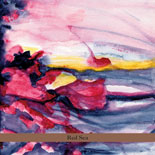 |
| A few words about Dave Taylor... in case you don't know. Dave is one of the most important instrumentalists in modern NY history... he redefined the bass trombone in the 1970's, bringing flexibility and personality to an instrument that previously had a very narrow range. As a cross-over classical/studio musician, he played every gig in town (including Duke Ellington) and was a member of Gil Evans' band at Sweet Basil. Over the years he has started to lead his own projects and I've had the pleasure of listening to many of them. Red Sea is without a doubt my favorite cd of his (full disclosure...Dave is a friend). I called him halfway through listening to this cd to tell him that this cd really does justice to his incredible vision. A stellar NY band.... Scott Robinson, Warren Smith and Adam Holzman ...check this out!!!! |
|

